Project Management
VerifiedAdded on 2023/04/21
|21
|4909
|272
AI Summary
This document provides comprehensive study material on project management including short question answers, project scope statement, project Gantt chart, project budget considerations, responses to risks, and quality methods for successful completion of a project.
Contribute Materials
Your contribution can guide someone’s learning journey. Share your
documents today.
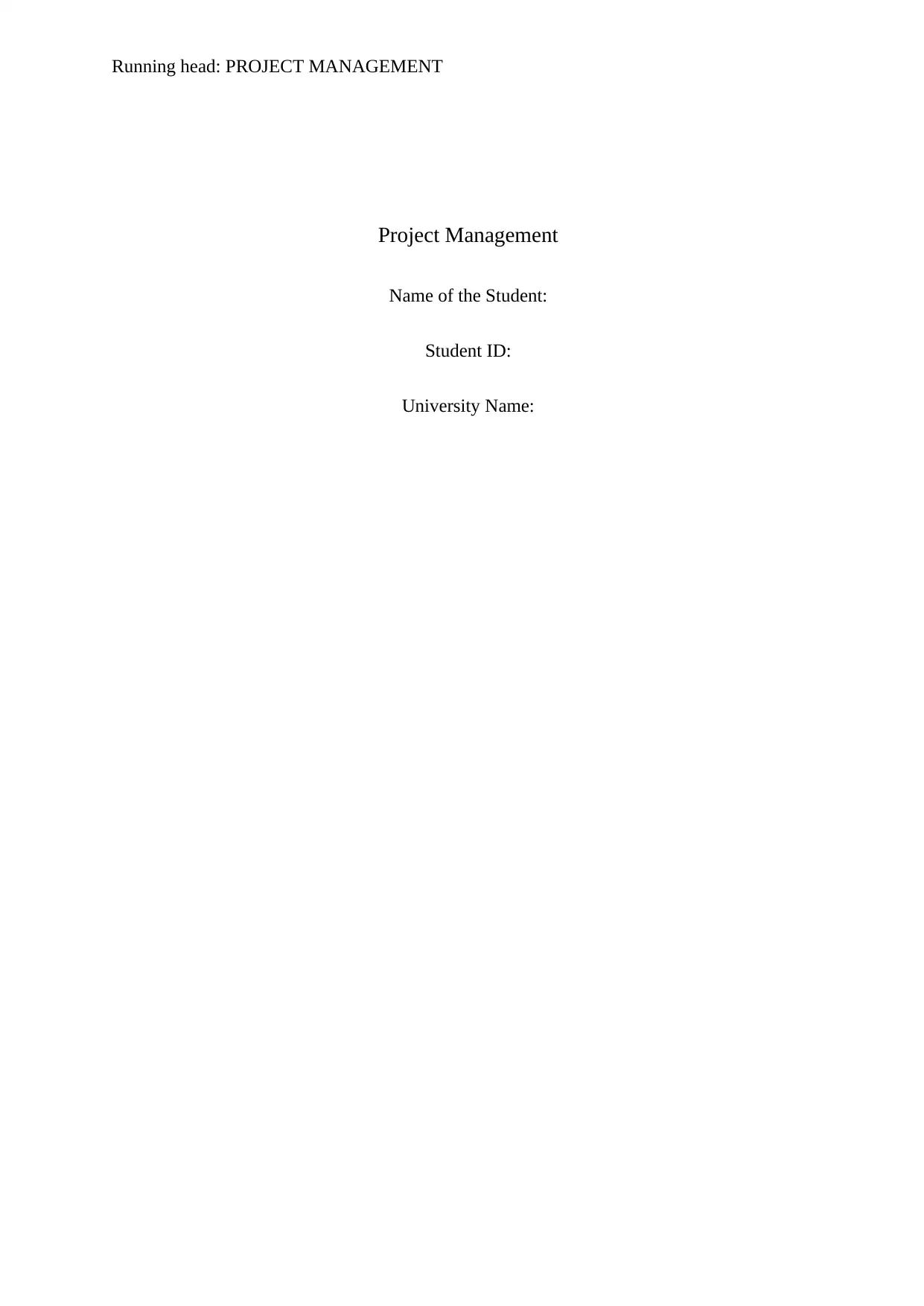
Running head: PROJECT MANAGEMENT
Project Management
Name of the Student:
Student ID:
University Name:
Project Management
Name of the Student:
Student ID:
University Name:
Secure Best Marks with AI Grader
Need help grading? Try our AI Grader for instant feedback on your assignments.
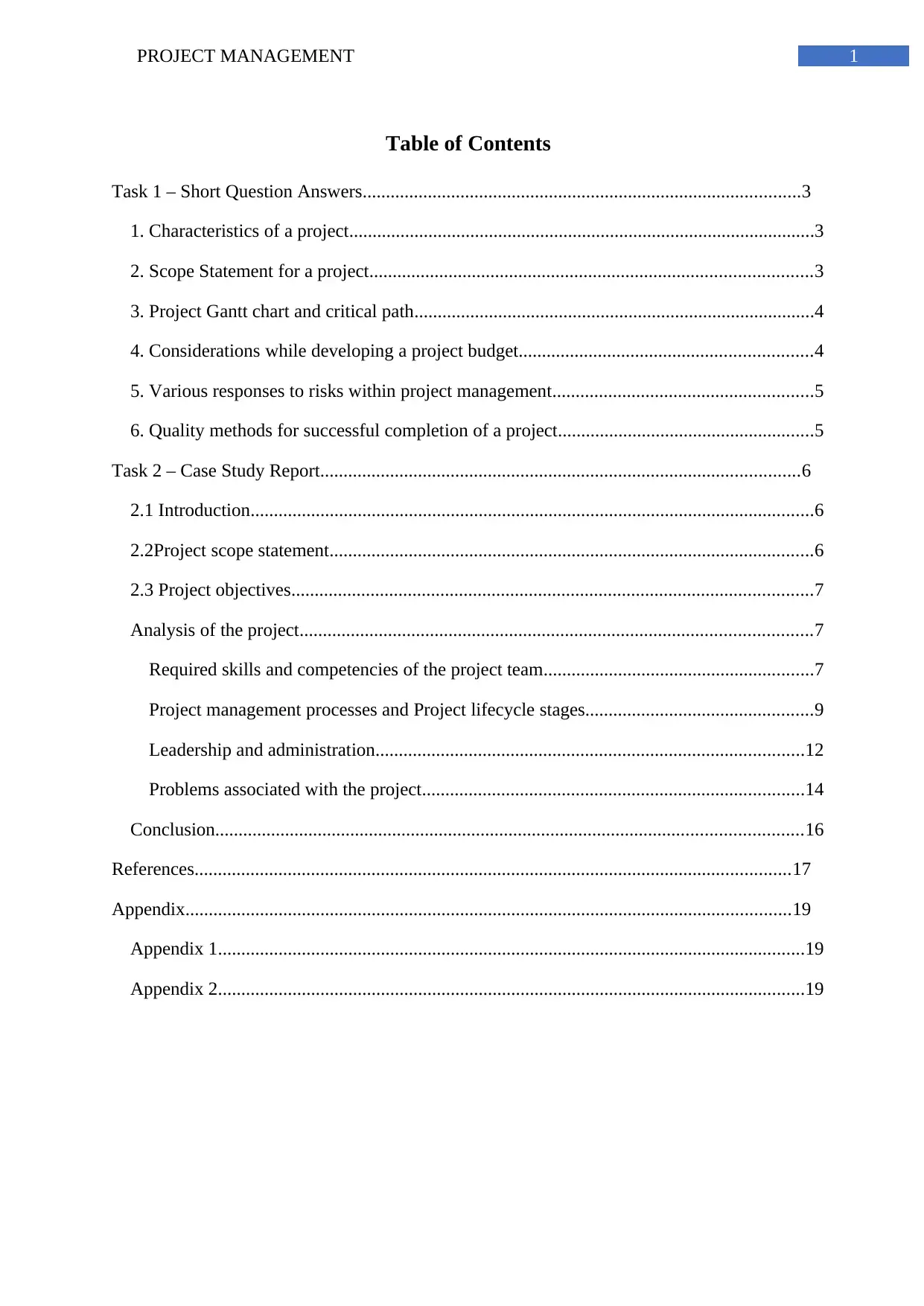
1PROJECT MANAGEMENT
Table of Contents
Task 1 – Short Question Answers..............................................................................................3
1. Characteristics of a project....................................................................................................3
2. Scope Statement for a project...............................................................................................3
3. Project Gantt chart and critical path......................................................................................4
4. Considerations while developing a project budget...............................................................4
5. Various responses to risks within project management........................................................5
6. Quality methods for successful completion of a project.......................................................5
Task 2 – Case Study Report.......................................................................................................6
2.1 Introduction.........................................................................................................................6
2.2Project scope statement........................................................................................................6
2.3 Project objectives................................................................................................................7
Analysis of the project..............................................................................................................7
Required skills and competencies of the project team..........................................................7
Project management processes and Project lifecycle stages.................................................9
Leadership and administration............................................................................................12
Problems associated with the project..................................................................................14
Conclusion..............................................................................................................................16
References................................................................................................................................17
Appendix..................................................................................................................................19
Appendix 1..............................................................................................................................19
Appendix 2..............................................................................................................................19
Table of Contents
Task 1 – Short Question Answers..............................................................................................3
1. Characteristics of a project....................................................................................................3
2. Scope Statement for a project...............................................................................................3
3. Project Gantt chart and critical path......................................................................................4
4. Considerations while developing a project budget...............................................................4
5. Various responses to risks within project management........................................................5
6. Quality methods for successful completion of a project.......................................................5
Task 2 – Case Study Report.......................................................................................................6
2.1 Introduction.........................................................................................................................6
2.2Project scope statement........................................................................................................6
2.3 Project objectives................................................................................................................7
Analysis of the project..............................................................................................................7
Required skills and competencies of the project team..........................................................7
Project management processes and Project lifecycle stages.................................................9
Leadership and administration............................................................................................12
Problems associated with the project..................................................................................14
Conclusion..............................................................................................................................16
References................................................................................................................................17
Appendix..................................................................................................................................19
Appendix 1..............................................................................................................................19
Appendix 2..............................................................................................................................19

2PROJECT MANAGEMENT
Task 1 – Short Question Answers
1. Characteristics of a project
The characteristics of a project are listed as below:
It is basically required for customers and taken by individual or organizations.
It is temporary in nature as well as it has a proposed start date and end date.
It has unique set of requirements defined by the customers that has to be
delivered within project boundaries (Kerzner and Kerzner 2017).
A project typically consists of various activities rather than just something
which is happening in a repeated manner.
A project is not just business and it has similarity with a process (Fleming and
Koppelman 2016).
A project can be cross-functional or may be cross-organization.
2. Scope Statement for a project
A project scope statement is used as tool for outlining the deliverables of a project and
identification of constraints, assumptions along with key success factors of a project. The
project boundaries will be clearly defined in a well written scope statement of a project
(Walker 2015). The scope statement is considered as an essential element for successful
completion of a project. Scope statement is used by the project managers as a document which
demonstrates the results that will be produced from the project. The work will be done based
on the constraints and as well as assumptions. The client for whom the project will be executed
or the project team who will be carrying out the project should agree upon the terms and
conditions that are mentioned in the scope statement prior to beginning of the work (Heagney
2016). A scope statement that is written well serves as an important resource so that the
expectation of stakeholders could be managed efficiently.
Task 1 – Short Question Answers
1. Characteristics of a project
The characteristics of a project are listed as below:
It is basically required for customers and taken by individual or organizations.
It is temporary in nature as well as it has a proposed start date and end date.
It has unique set of requirements defined by the customers that has to be
delivered within project boundaries (Kerzner and Kerzner 2017).
A project typically consists of various activities rather than just something
which is happening in a repeated manner.
A project is not just business and it has similarity with a process (Fleming and
Koppelman 2016).
A project can be cross-functional or may be cross-organization.
2. Scope Statement for a project
A project scope statement is used as tool for outlining the deliverables of a project and
identification of constraints, assumptions along with key success factors of a project. The
project boundaries will be clearly defined in a well written scope statement of a project
(Walker 2015). The scope statement is considered as an essential element for successful
completion of a project. Scope statement is used by the project managers as a document which
demonstrates the results that will be produced from the project. The work will be done based
on the constraints and as well as assumptions. The client for whom the project will be executed
or the project team who will be carrying out the project should agree upon the terms and
conditions that are mentioned in the scope statement prior to beginning of the work (Heagney
2016). A scope statement that is written well serves as an important resource so that the
expectation of stakeholders could be managed efficiently.

3PROJECT MANAGEMENT
3. Project Gantt chart and critical path
The critical path for this project is acf and the project will require 11 days for
completion of the project.
4. Considerations while developing a project budget
The preparation of budget is considered as a critical factor in context to planning or
execution of a project. For successful completion of a project, it is essential to estimate a
derailed forecast of the required costs irrespective of the industry or scale of the project.
Generally, a budget plan comprises of costs associate with labour and materials (Harrison and
Lock 2017). On the other hand, there are various other costs which should be taken into
consideration during planning of project budget to ensure success of the project. The
considerations for developing budget for a project is described as below:
Calculation of anticipated costs – The first step that is required for preparing a project
budget is calculating the anticipated costs. Many projects become failure if the cost for
completion exceeds the estimated budget as the potential costs may not be estimated properly
(Nicholas and Steyn 2017). For completion of a project, specific amount of budget required for
the project is assigned to different activities.
Preparation for change in budget – The initial costs identified for a project includes
approximate potential costs which may have impact on the project. The initial costs comprise
of the direct or indirect costs that may change during execution of the project (Kerzner 2018).
3. Project Gantt chart and critical path
The critical path for this project is acf and the project will require 11 days for
completion of the project.
4. Considerations while developing a project budget
The preparation of budget is considered as a critical factor in context to planning or
execution of a project. For successful completion of a project, it is essential to estimate a
derailed forecast of the required costs irrespective of the industry or scale of the project.
Generally, a budget plan comprises of costs associate with labour and materials (Harrison and
Lock 2017). On the other hand, there are various other costs which should be taken into
consideration during planning of project budget to ensure success of the project. The
considerations for developing budget for a project is described as below:
Calculation of anticipated costs – The first step that is required for preparing a project
budget is calculating the anticipated costs. Many projects become failure if the cost for
completion exceeds the estimated budget as the potential costs may not be estimated properly
(Nicholas and Steyn 2017). For completion of a project, specific amount of budget required for
the project is assigned to different activities.
Preparation for change in budget – The initial costs identified for a project includes
approximate potential costs which may have impact on the project. The initial costs comprise
of the direct or indirect costs that may change during execution of the project (Kerzner 2018).
Secure Best Marks with AI Grader
Need help grading? Try our AI Grader for instant feedback on your assignments.
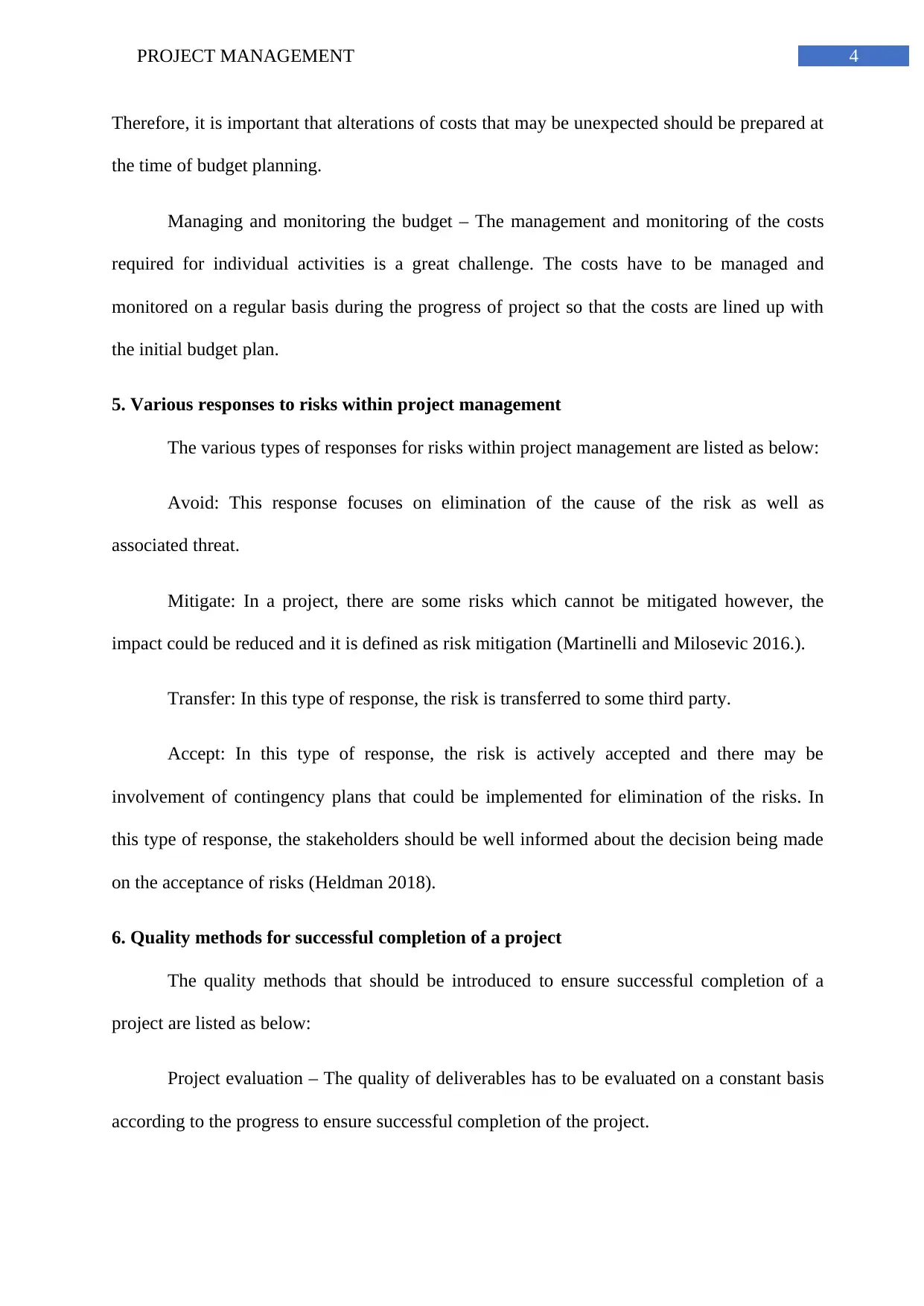
4PROJECT MANAGEMENT
Therefore, it is important that alterations of costs that may be unexpected should be prepared at
the time of budget planning.
Managing and monitoring the budget – The management and monitoring of the costs
required for individual activities is a great challenge. The costs have to be managed and
monitored on a regular basis during the progress of project so that the costs are lined up with
the initial budget plan.
5. Various responses to risks within project management
The various types of responses for risks within project management are listed as below:
Avoid: This response focuses on elimination of the cause of the risk as well as
associated threat.
Mitigate: In a project, there are some risks which cannot be mitigated however, the
impact could be reduced and it is defined as risk mitigation (Martinelli and Milosevic 2016.).
Transfer: In this type of response, the risk is transferred to some third party.
Accept: In this type of response, the risk is actively accepted and there may be
involvement of contingency plans that could be implemented for elimination of the risks. In
this type of response, the stakeholders should be well informed about the decision being made
on the acceptance of risks (Heldman 2018).
6. Quality methods for successful completion of a project
The quality methods that should be introduced to ensure successful completion of a
project are listed as below:
Project evaluation – The quality of deliverables has to be evaluated on a constant basis
according to the progress to ensure successful completion of the project.
Therefore, it is important that alterations of costs that may be unexpected should be prepared at
the time of budget planning.
Managing and monitoring the budget – The management and monitoring of the costs
required for individual activities is a great challenge. The costs have to be managed and
monitored on a regular basis during the progress of project so that the costs are lined up with
the initial budget plan.
5. Various responses to risks within project management
The various types of responses for risks within project management are listed as below:
Avoid: This response focuses on elimination of the cause of the risk as well as
associated threat.
Mitigate: In a project, there are some risks which cannot be mitigated however, the
impact could be reduced and it is defined as risk mitigation (Martinelli and Milosevic 2016.).
Transfer: In this type of response, the risk is transferred to some third party.
Accept: In this type of response, the risk is actively accepted and there may be
involvement of contingency plans that could be implemented for elimination of the risks. In
this type of response, the stakeholders should be well informed about the decision being made
on the acceptance of risks (Heldman 2018).
6. Quality methods for successful completion of a project
The quality methods that should be introduced to ensure successful completion of a
project are listed as below:
Project evaluation – The quality of deliverables has to be evaluated on a constant basis
according to the progress to ensure successful completion of the project.
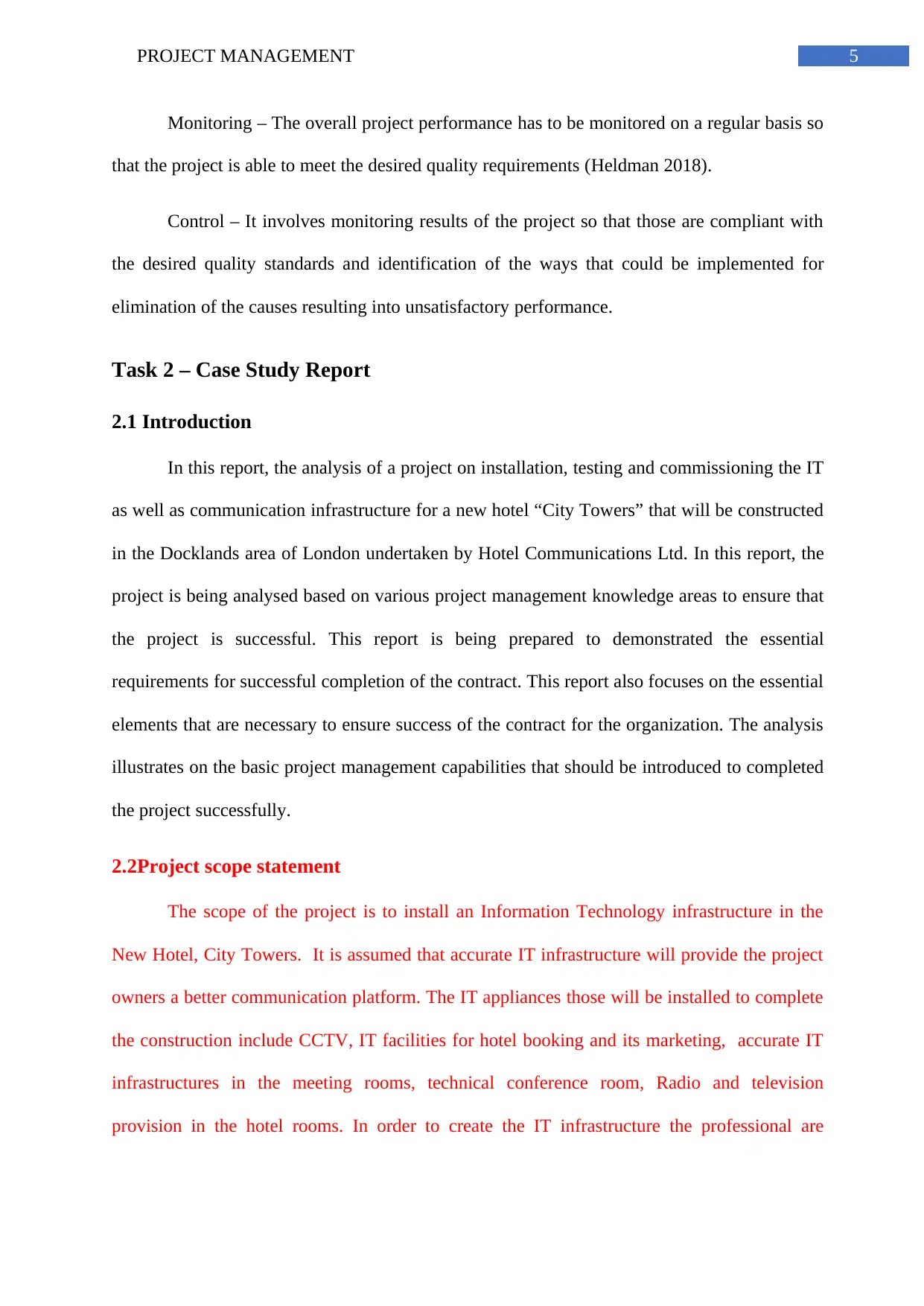
5PROJECT MANAGEMENT
Monitoring – The overall project performance has to be monitored on a regular basis so
that the project is able to meet the desired quality requirements (Heldman 2018).
Control – It involves monitoring results of the project so that those are compliant with
the desired quality standards and identification of the ways that could be implemented for
elimination of the causes resulting into unsatisfactory performance.
Task 2 – Case Study Report
2.1 Introduction
In this report, the analysis of a project on installation, testing and commissioning the IT
as well as communication infrastructure for a new hotel “City Towers” that will be constructed
in the Docklands area of London undertaken by Hotel Communications Ltd. In this report, the
project is being analysed based on various project management knowledge areas to ensure that
the project is successful. This report is being prepared to demonstrated the essential
requirements for successful completion of the contract. This report also focuses on the essential
elements that are necessary to ensure success of the contract for the organization. The analysis
illustrates on the basic project management capabilities that should be introduced to completed
the project successfully.
2.2Project scope statement
The scope of the project is to install an Information Technology infrastructure in the
New Hotel, City Towers. It is assumed that accurate IT infrastructure will provide the project
owners a better communication platform. The IT appliances those will be installed to complete
the construction include CCTV, IT facilities for hotel booking and its marketing, accurate IT
infrastructures in the meeting rooms, technical conference room, Radio and television
provision in the hotel rooms. In order to create the IT infrastructure the professional are
Monitoring – The overall project performance has to be monitored on a regular basis so
that the project is able to meet the desired quality requirements (Heldman 2018).
Control – It involves monitoring results of the project so that those are compliant with
the desired quality standards and identification of the ways that could be implemented for
elimination of the causes resulting into unsatisfactory performance.
Task 2 – Case Study Report
2.1 Introduction
In this report, the analysis of a project on installation, testing and commissioning the IT
as well as communication infrastructure for a new hotel “City Towers” that will be constructed
in the Docklands area of London undertaken by Hotel Communications Ltd. In this report, the
project is being analysed based on various project management knowledge areas to ensure that
the project is successful. This report is being prepared to demonstrated the essential
requirements for successful completion of the contract. This report also focuses on the essential
elements that are necessary to ensure success of the contract for the organization. The analysis
illustrates on the basic project management capabilities that should be introduced to completed
the project successfully.
2.2Project scope statement
The scope of the project is to install an Information Technology infrastructure in the
New Hotel, City Towers. It is assumed that accurate IT infrastructure will provide the project
owners a better communication platform. The IT appliances those will be installed to complete
the construction include CCTV, IT facilities for hotel booking and its marketing, accurate IT
infrastructures in the meeting rooms, technical conference room, Radio and television
provision in the hotel rooms. In order to create the IT infrastructure the professional are
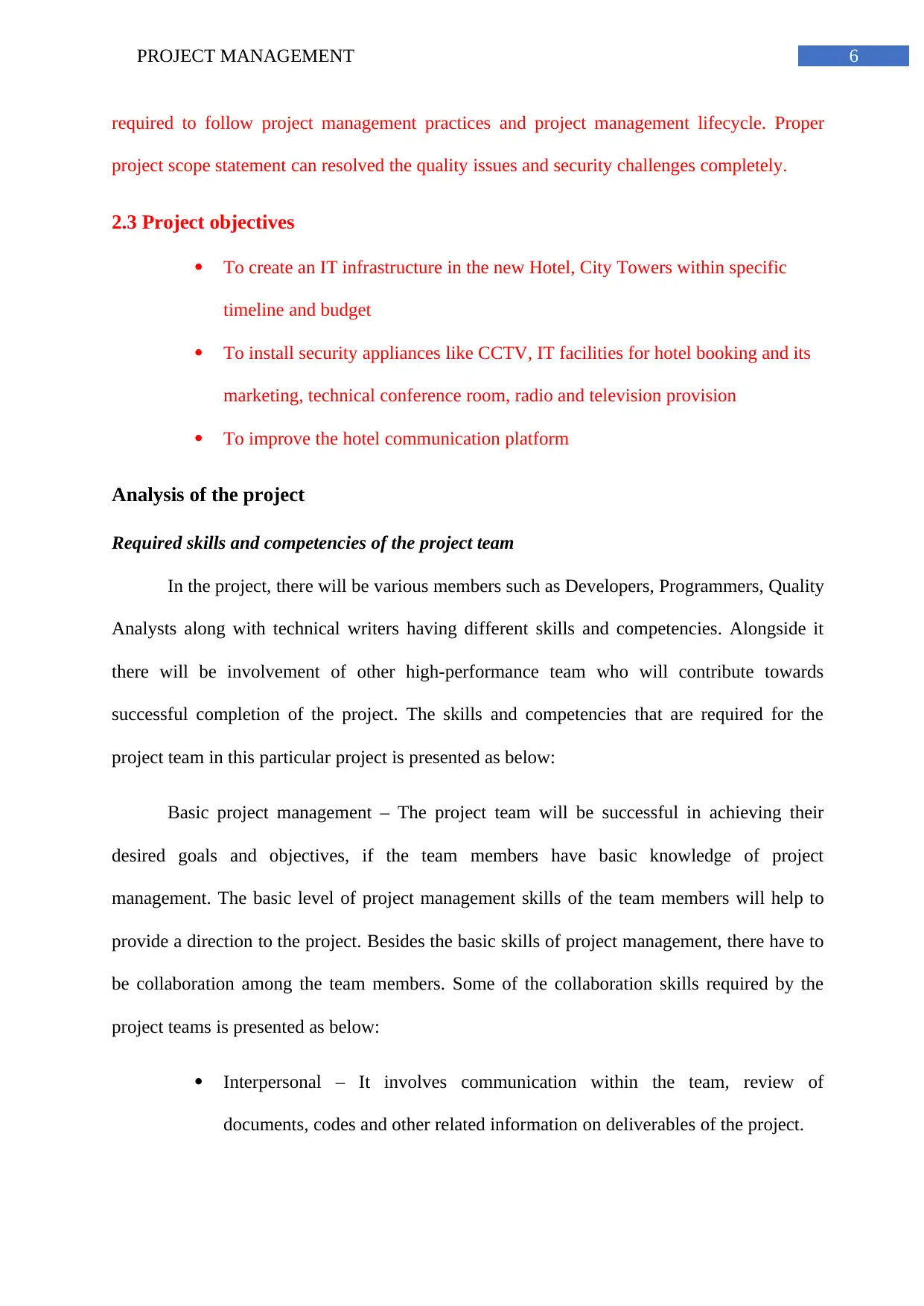
6PROJECT MANAGEMENT
required to follow project management practices and project management lifecycle. Proper
project scope statement can resolved the quality issues and security challenges completely.
2.3 Project objectives
To create an IT infrastructure in the new Hotel, City Towers within specific
timeline and budget
To install security appliances like CCTV, IT facilities for hotel booking and its
marketing, technical conference room, radio and television provision
To improve the hotel communication platform
Analysis of the project
Required skills and competencies of the project team
In the project, there will be various members such as Developers, Programmers, Quality
Analysts along with technical writers having different skills and competencies. Alongside it
there will be involvement of other high-performance team who will contribute towards
successful completion of the project. The skills and competencies that are required for the
project team in this particular project is presented as below:
Basic project management – The project team will be successful in achieving their
desired goals and objectives, if the team members have basic knowledge of project
management. The basic level of project management skills of the team members will help to
provide a direction to the project. Besides the basic skills of project management, there have to
be collaboration among the team members. Some of the collaboration skills required by the
project teams is presented as below:
Interpersonal – It involves communication within the team, review of
documents, codes and other related information on deliverables of the project.
required to follow project management practices and project management lifecycle. Proper
project scope statement can resolved the quality issues and security challenges completely.
2.3 Project objectives
To create an IT infrastructure in the new Hotel, City Towers within specific
timeline and budget
To install security appliances like CCTV, IT facilities for hotel booking and its
marketing, technical conference room, radio and television provision
To improve the hotel communication platform
Analysis of the project
Required skills and competencies of the project team
In the project, there will be various members such as Developers, Programmers, Quality
Analysts along with technical writers having different skills and competencies. Alongside it
there will be involvement of other high-performance team who will contribute towards
successful completion of the project. The skills and competencies that are required for the
project team in this particular project is presented as below:
Basic project management – The project team will be successful in achieving their
desired goals and objectives, if the team members have basic knowledge of project
management. The basic level of project management skills of the team members will help to
provide a direction to the project. Besides the basic skills of project management, there have to
be collaboration among the team members. Some of the collaboration skills required by the
project teams is presented as below:
Interpersonal – It involves communication within the team, review of
documents, codes and other related information on deliverables of the project.
Paraphrase This Document
Need a fresh take? Get an instant paraphrase of this document with our AI Paraphraser
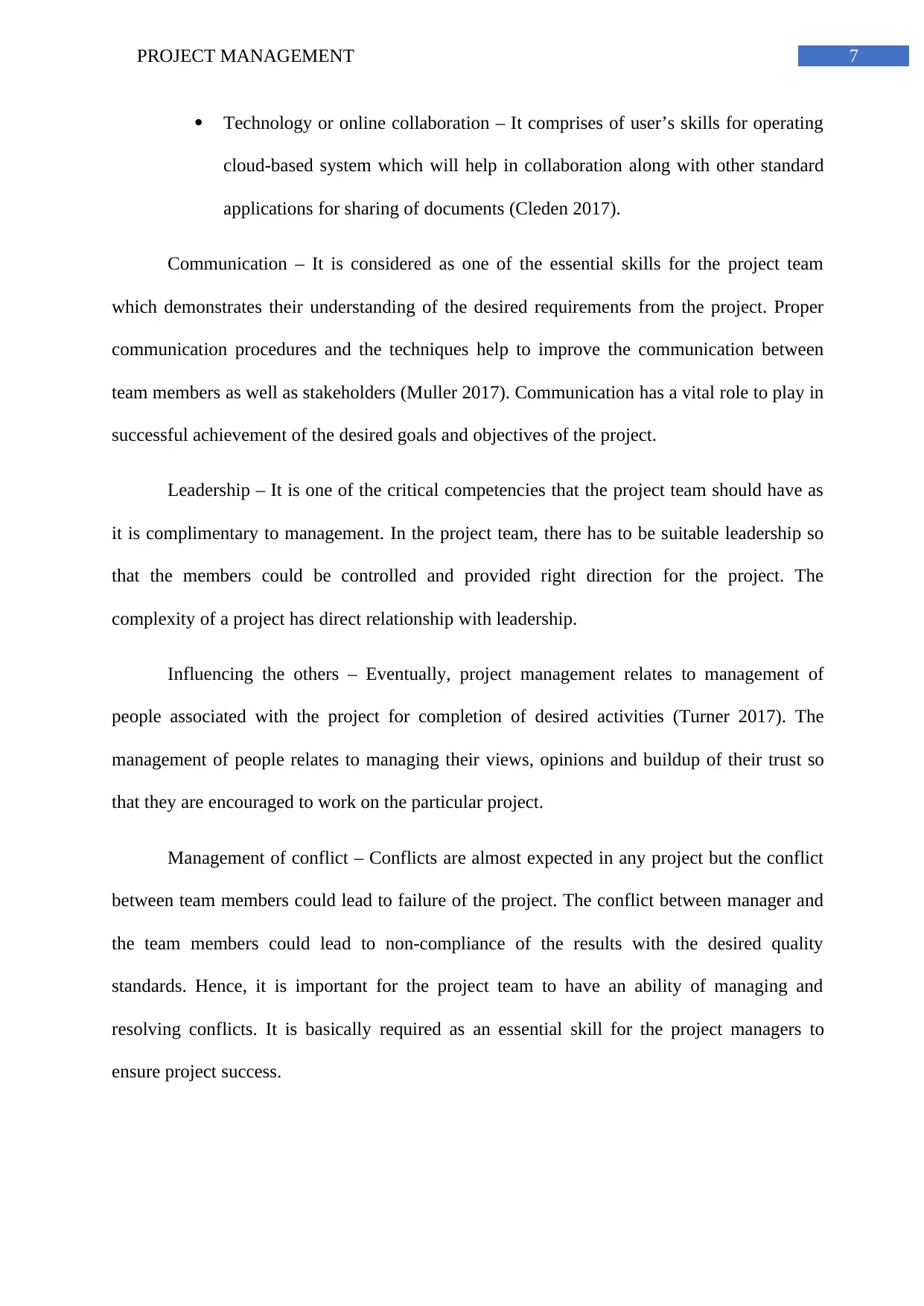
7PROJECT MANAGEMENT
Technology or online collaboration – It comprises of user’s skills for operating
cloud-based system which will help in collaboration along with other standard
applications for sharing of documents (Cleden 2017).
Communication – It is considered as one of the essential skills for the project team
which demonstrates their understanding of the desired requirements from the project. Proper
communication procedures and the techniques help to improve the communication between
team members as well as stakeholders (Muller 2017). Communication has a vital role to play in
successful achievement of the desired goals and objectives of the project.
Leadership – It is one of the critical competencies that the project team should have as
it is complimentary to management. In the project team, there has to be suitable leadership so
that the members could be controlled and provided right direction for the project. The
complexity of a project has direct relationship with leadership.
Influencing the others – Eventually, project management relates to management of
people associated with the project for completion of desired activities (Turner 2017). The
management of people relates to managing their views, opinions and buildup of their trust so
that they are encouraged to work on the particular project.
Management of conflict – Conflicts are almost expected in any project but the conflict
between team members could lead to failure of the project. The conflict between manager and
the team members could lead to non-compliance of the results with the desired quality
standards. Hence, it is important for the project team to have an ability of managing and
resolving conflicts. It is basically required as an essential skill for the project managers to
ensure project success.
Technology or online collaboration – It comprises of user’s skills for operating
cloud-based system which will help in collaboration along with other standard
applications for sharing of documents (Cleden 2017).
Communication – It is considered as one of the essential skills for the project team
which demonstrates their understanding of the desired requirements from the project. Proper
communication procedures and the techniques help to improve the communication between
team members as well as stakeholders (Muller 2017). Communication has a vital role to play in
successful achievement of the desired goals and objectives of the project.
Leadership – It is one of the critical competencies that the project team should have as
it is complimentary to management. In the project team, there has to be suitable leadership so
that the members could be controlled and provided right direction for the project. The
complexity of a project has direct relationship with leadership.
Influencing the others – Eventually, project management relates to management of
people associated with the project for completion of desired activities (Turner 2017). The
management of people relates to managing their views, opinions and buildup of their trust so
that they are encouraged to work on the particular project.
Management of conflict – Conflicts are almost expected in any project but the conflict
between team members could lead to failure of the project. The conflict between manager and
the team members could lead to non-compliance of the results with the desired quality
standards. Hence, it is important for the project team to have an ability of managing and
resolving conflicts. It is basically required as an essential skill for the project managers to
ensure project success.
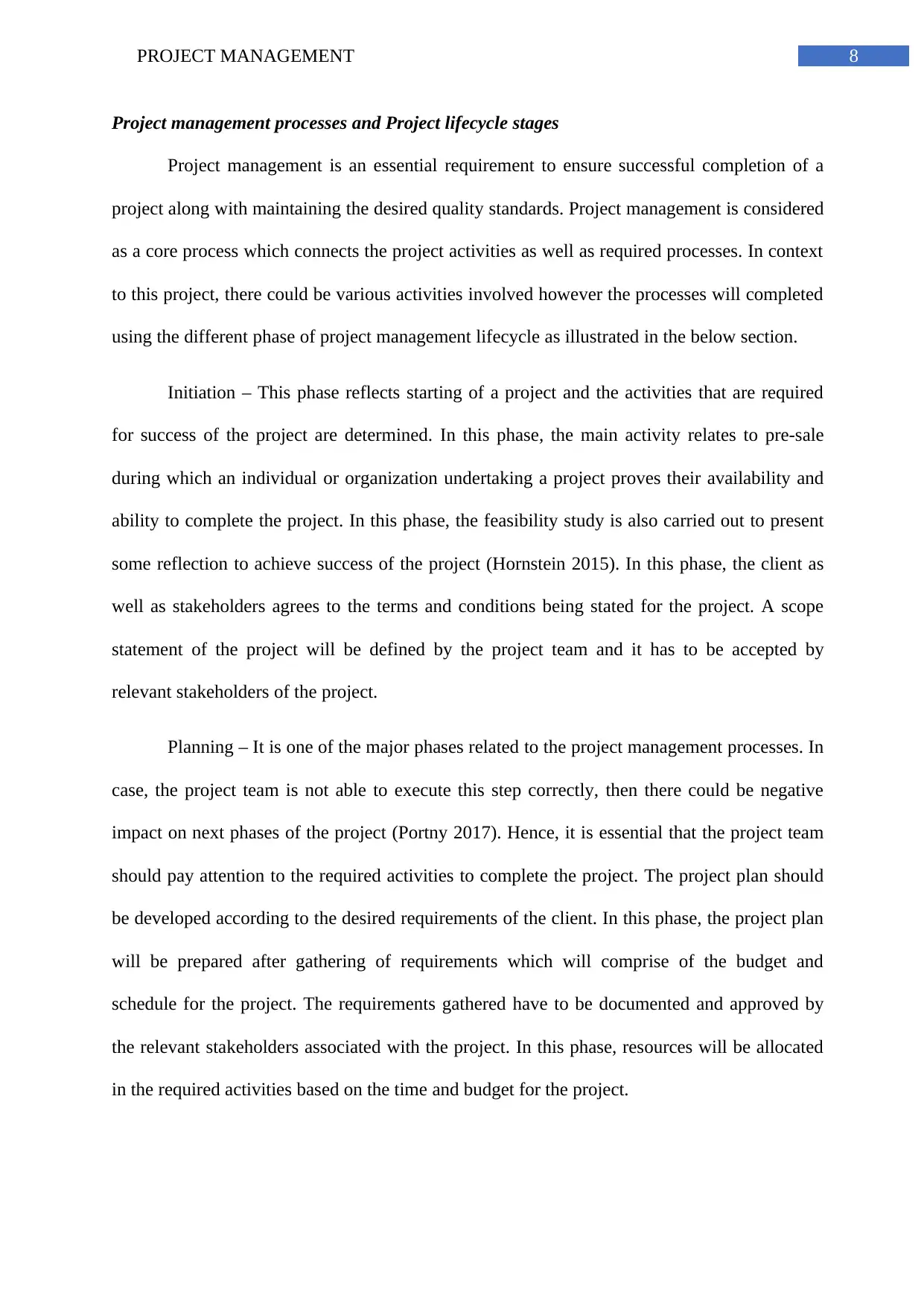
8PROJECT MANAGEMENT
Project management processes and Project lifecycle stages
Project management is an essential requirement to ensure successful completion of a
project along with maintaining the desired quality standards. Project management is considered
as a core process which connects the project activities as well as required processes. In context
to this project, there could be various activities involved however the processes will completed
using the different phase of project management lifecycle as illustrated in the below section.
Initiation – This phase reflects starting of a project and the activities that are required
for success of the project are determined. In this phase, the main activity relates to pre-sale
during which an individual or organization undertaking a project proves their availability and
ability to complete the project. In this phase, the feasibility study is also carried out to present
some reflection to achieve success of the project (Hornstein 2015). In this phase, the client as
well as stakeholders agrees to the terms and conditions being stated for the project. A scope
statement of the project will be defined by the project team and it has to be accepted by
relevant stakeholders of the project.
Planning – It is one of the major phases related to the project management processes. In
case, the project team is not able to execute this step correctly, then there could be negative
impact on next phases of the project (Portny 2017). Hence, it is essential that the project team
should pay attention to the required activities to complete the project. The project plan should
be developed according to the desired requirements of the client. In this phase, the project plan
will be prepared after gathering of requirements which will comprise of the budget and
schedule for the project. The requirements gathered have to be documented and approved by
the relevant stakeholders associated with the project. In this phase, resources will be allocated
in the required activities based on the time and budget for the project.
Project management processes and Project lifecycle stages
Project management is an essential requirement to ensure successful completion of a
project along with maintaining the desired quality standards. Project management is considered
as a core process which connects the project activities as well as required processes. In context
to this project, there could be various activities involved however the processes will completed
using the different phase of project management lifecycle as illustrated in the below section.
Initiation – This phase reflects starting of a project and the activities that are required
for success of the project are determined. In this phase, the main activity relates to pre-sale
during which an individual or organization undertaking a project proves their availability and
ability to complete the project. In this phase, the feasibility study is also carried out to present
some reflection to achieve success of the project (Hornstein 2015). In this phase, the client as
well as stakeholders agrees to the terms and conditions being stated for the project. A scope
statement of the project will be defined by the project team and it has to be accepted by
relevant stakeholders of the project.
Planning – It is one of the major phases related to the project management processes. In
case, the project team is not able to execute this step correctly, then there could be negative
impact on next phases of the project (Portny 2017). Hence, it is essential that the project team
should pay attention to the required activities to complete the project. The project plan should
be developed according to the desired requirements of the client. In this phase, the project plan
will be prepared after gathering of requirements which will comprise of the budget and
schedule for the project. The requirements gathered have to be documented and approved by
the relevant stakeholders associated with the project. In this phase, resources will be allocated
in the required activities based on the time and budget for the project.
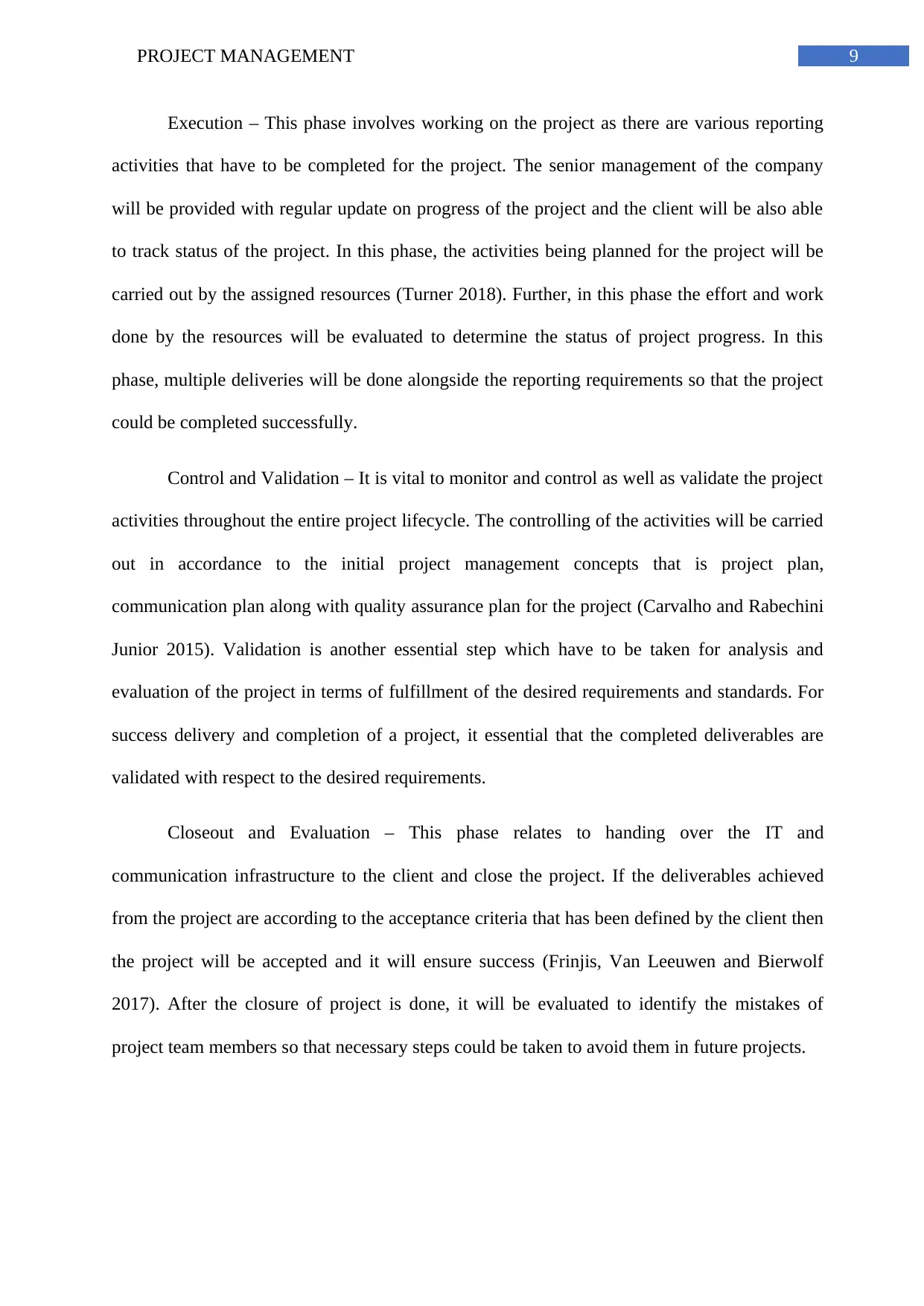
9PROJECT MANAGEMENT
Execution – This phase involves working on the project as there are various reporting
activities that have to be completed for the project. The senior management of the company
will be provided with regular update on progress of the project and the client will be also able
to track status of the project. In this phase, the activities being planned for the project will be
carried out by the assigned resources (Turner 2018). Further, in this phase the effort and work
done by the resources will be evaluated to determine the status of project progress. In this
phase, multiple deliveries will be done alongside the reporting requirements so that the project
could be completed successfully.
Control and Validation – It is vital to monitor and control as well as validate the project
activities throughout the entire project lifecycle. The controlling of the activities will be carried
out in accordance to the initial project management concepts that is project plan,
communication plan along with quality assurance plan for the project (Carvalho and Rabechini
Junior 2015). Validation is another essential step which have to be taken for analysis and
evaluation of the project in terms of fulfillment of the desired requirements and standards. For
success delivery and completion of a project, it essential that the completed deliverables are
validated with respect to the desired requirements.
Closeout and Evaluation – This phase relates to handing over the IT and
communication infrastructure to the client and close the project. If the deliverables achieved
from the project are according to the acceptance criteria that has been defined by the client then
the project will be accepted and it will ensure success (Frinjis, Van Leeuwen and Bierwolf
2017). After the closure of project is done, it will be evaluated to identify the mistakes of
project team members so that necessary steps could be taken to avoid them in future projects.
Execution – This phase involves working on the project as there are various reporting
activities that have to be completed for the project. The senior management of the company
will be provided with regular update on progress of the project and the client will be also able
to track status of the project. In this phase, the activities being planned for the project will be
carried out by the assigned resources (Turner 2018). Further, in this phase the effort and work
done by the resources will be evaluated to determine the status of project progress. In this
phase, multiple deliveries will be done alongside the reporting requirements so that the project
could be completed successfully.
Control and Validation – It is vital to monitor and control as well as validate the project
activities throughout the entire project lifecycle. The controlling of the activities will be carried
out in accordance to the initial project management concepts that is project plan,
communication plan along with quality assurance plan for the project (Carvalho and Rabechini
Junior 2015). Validation is another essential step which have to be taken for analysis and
evaluation of the project in terms of fulfillment of the desired requirements and standards. For
success delivery and completion of a project, it essential that the completed deliverables are
validated with respect to the desired requirements.
Closeout and Evaluation – This phase relates to handing over the IT and
communication infrastructure to the client and close the project. If the deliverables achieved
from the project are according to the acceptance criteria that has been defined by the client then
the project will be accepted and it will ensure success (Frinjis, Van Leeuwen and Bierwolf
2017). After the closure of project is done, it will be evaluated to identify the mistakes of
project team members so that necessary steps could be taken to avoid them in future projects.
Secure Best Marks with AI Grader
Need help grading? Try our AI Grader for instant feedback on your assignments.
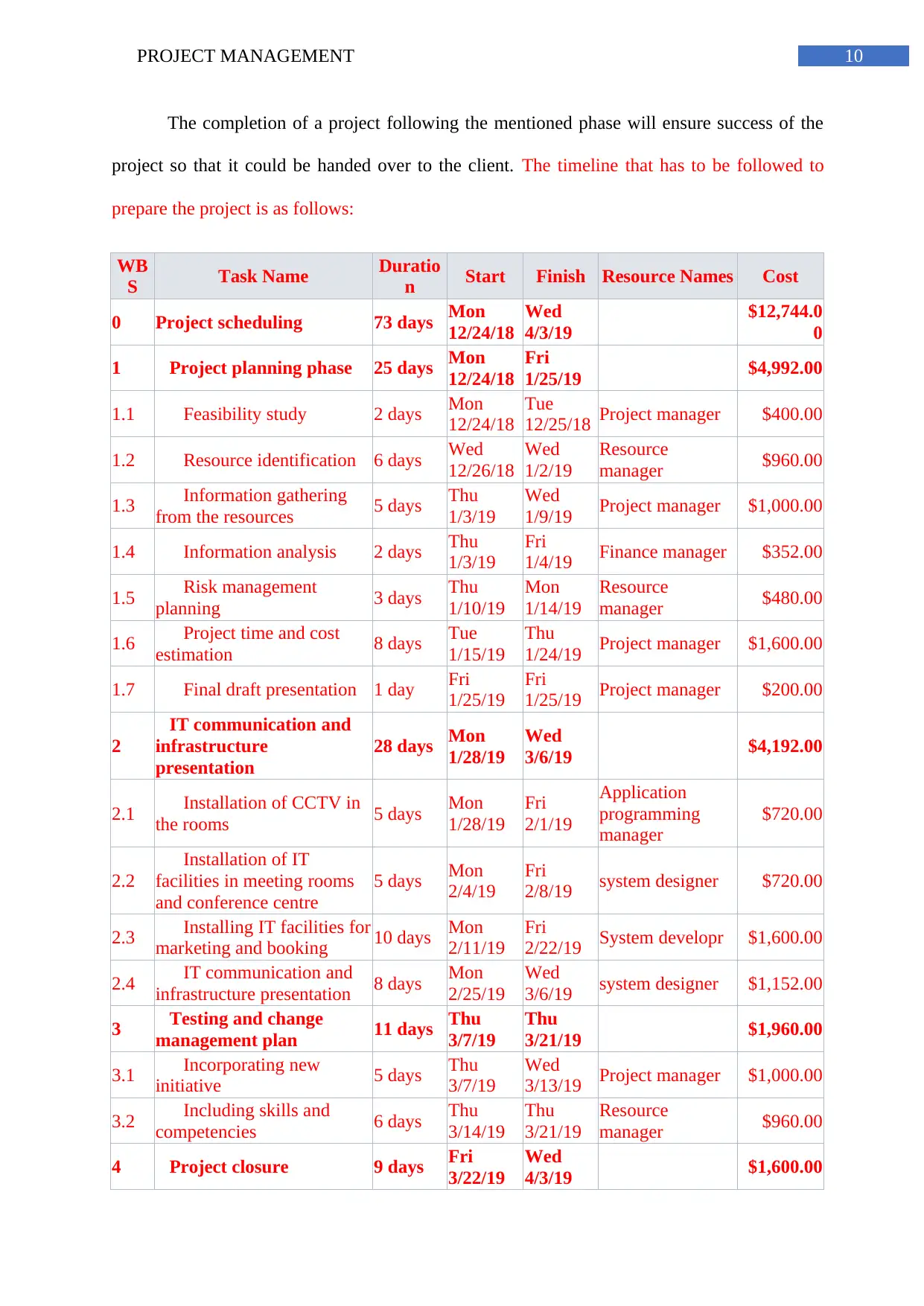
10PROJECT MANAGEMENT
The completion of a project following the mentioned phase will ensure success of the
project so that it could be handed over to the client. The timeline that has to be followed to
prepare the project is as follows:
WB
S Task Name Duratio
n Start Finish Resource Names Cost
0 Project scheduling 73 days Mon
12/24/18
Wed
4/3/19
$12,744.0
0
1 Project planning phase 25 days Mon
12/24/18
Fri
1/25/19 $4,992.00
1.1 Feasibility study 2 days Mon
12/24/18
Tue
12/25/18 Project manager $400.00
1.2 Resource identification 6 days Wed
12/26/18
Wed
1/2/19
Resource
manager $960.00
1.3 Information gathering
from the resources 5 days Thu
1/3/19
Wed
1/9/19 Project manager $1,000.00
1.4 Information analysis 2 days Thu
1/3/19
Fri
1/4/19 Finance manager $352.00
1.5 Risk management
planning 3 days Thu
1/10/19
Mon
1/14/19
Resource
manager $480.00
1.6 Project time and cost
estimation 8 days Tue
1/15/19
Thu
1/24/19 Project manager $1,600.00
1.7 Final draft presentation 1 day Fri
1/25/19
Fri
1/25/19 Project manager $200.00
2
IT communication and
infrastructure
presentation
28 days Mon
1/28/19
Wed
3/6/19 $4,192.00
2.1 Installation of CCTV in
the rooms 5 days Mon
1/28/19
Fri
2/1/19
Application
programming
manager
$720.00
2.2
Installation of IT
facilities in meeting rooms
and conference centre
5 days Mon
2/4/19
Fri
2/8/19 system designer $720.00
2.3 Installing IT facilities for
marketing and booking 10 days Mon
2/11/19
Fri
2/22/19 System developr $1,600.00
2.4 IT communication and
infrastructure presentation 8 days Mon
2/25/19
Wed
3/6/19 system designer $1,152.00
3 Testing and change
management plan 11 days Thu
3/7/19
Thu
3/21/19 $1,960.00
3.1 Incorporating new
initiative 5 days Thu
3/7/19
Wed
3/13/19 Project manager $1,000.00
3.2 Including skills and
competencies 6 days Thu
3/14/19
Thu
3/21/19
Resource
manager $960.00
4 Project closure 9 days Fri
3/22/19
Wed
4/3/19 $1,600.00
The completion of a project following the mentioned phase will ensure success of the
project so that it could be handed over to the client. The timeline that has to be followed to
prepare the project is as follows:
WB
S Task Name Duratio
n Start Finish Resource Names Cost
0 Project scheduling 73 days Mon
12/24/18
Wed
4/3/19
$12,744.0
0
1 Project planning phase 25 days Mon
12/24/18
Fri
1/25/19 $4,992.00
1.1 Feasibility study 2 days Mon
12/24/18
Tue
12/25/18 Project manager $400.00
1.2 Resource identification 6 days Wed
12/26/18
Wed
1/2/19
Resource
manager $960.00
1.3 Information gathering
from the resources 5 days Thu
1/3/19
Wed
1/9/19 Project manager $1,000.00
1.4 Information analysis 2 days Thu
1/3/19
Fri
1/4/19 Finance manager $352.00
1.5 Risk management
planning 3 days Thu
1/10/19
Mon
1/14/19
Resource
manager $480.00
1.6 Project time and cost
estimation 8 days Tue
1/15/19
Thu
1/24/19 Project manager $1,600.00
1.7 Final draft presentation 1 day Fri
1/25/19
Fri
1/25/19 Project manager $200.00
2
IT communication and
infrastructure
presentation
28 days Mon
1/28/19
Wed
3/6/19 $4,192.00
2.1 Installation of CCTV in
the rooms 5 days Mon
1/28/19
Fri
2/1/19
Application
programming
manager
$720.00
2.2
Installation of IT
facilities in meeting rooms
and conference centre
5 days Mon
2/4/19
Fri
2/8/19 system designer $720.00
2.3 Installing IT facilities for
marketing and booking 10 days Mon
2/11/19
Fri
2/22/19 System developr $1,600.00
2.4 IT communication and
infrastructure presentation 8 days Mon
2/25/19
Wed
3/6/19 system designer $1,152.00
3 Testing and change
management plan 11 days Thu
3/7/19
Thu
3/21/19 $1,960.00
3.1 Incorporating new
initiative 5 days Thu
3/7/19
Wed
3/13/19 Project manager $1,000.00
3.2 Including skills and
competencies 6 days Thu
3/14/19
Thu
3/21/19
Resource
manager $960.00
4 Project closure 9 days Fri
3/22/19
Wed
4/3/19 $1,600.00
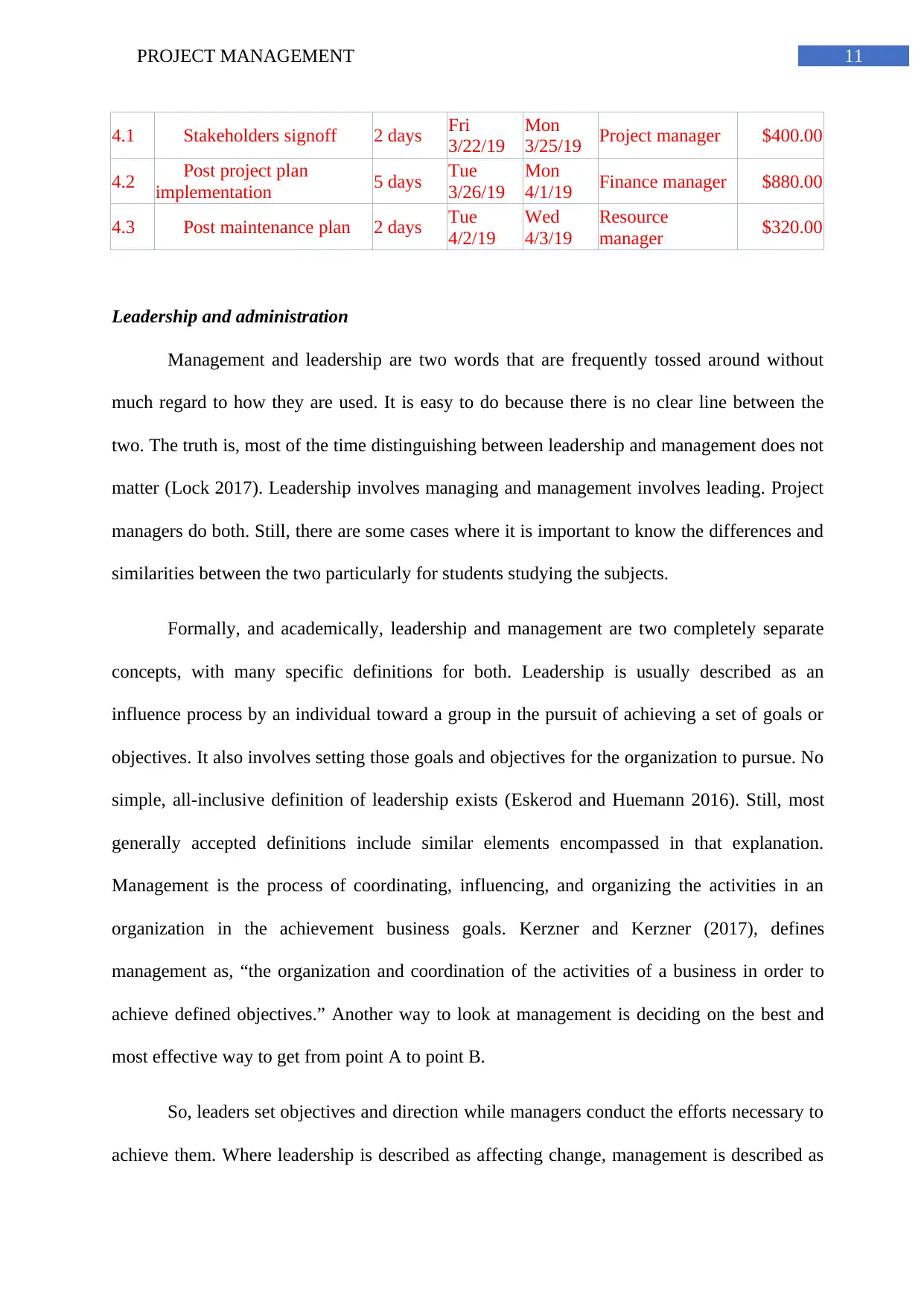
11PROJECT MANAGEMENT
4.1 Stakeholders signoff 2 days Fri
3/22/19
Mon
3/25/19 Project manager $400.00
4.2 Post project plan
implementation 5 days Tue
3/26/19
Mon
4/1/19 Finance manager $880.00
4.3 Post maintenance plan 2 days Tue
4/2/19
Wed
4/3/19
Resource
manager $320.00
Leadership and administration
Management and leadership are two words that are frequently tossed around without
much regard to how they are used. It is easy to do because there is no clear line between the
two. The truth is, most of the time distinguishing between leadership and management does not
matter (Lock 2017). Leadership involves managing and management involves leading. Project
managers do both. Still, there are some cases where it is important to know the differences and
similarities between the two particularly for students studying the subjects.
Formally, and academically, leadership and management are two completely separate
concepts, with many specific definitions for both. Leadership is usually described as an
influence process by an individual toward a group in the pursuit of achieving a set of goals or
objectives. It also involves setting those goals and objectives for the organization to pursue. No
simple, all-inclusive definition of leadership exists (Eskerod and Huemann 2016). Still, most
generally accepted definitions include similar elements encompassed in that explanation.
Management is the process of coordinating, influencing, and organizing the activities in an
organization in the achievement business goals. Kerzner and Kerzner (2017), defines
management as, “the organization and coordination of the activities of a business in order to
achieve defined objectives.” Another way to look at management is deciding on the best and
most effective way to get from point A to point B.
So, leaders set objectives and direction while managers conduct the efforts necessary to
achieve them. Where leadership is described as affecting change, management is described as
4.1 Stakeholders signoff 2 days Fri
3/22/19
Mon
3/25/19 Project manager $400.00
4.2 Post project plan
implementation 5 days Tue
3/26/19
Mon
4/1/19 Finance manager $880.00
4.3 Post maintenance plan 2 days Tue
4/2/19
Wed
4/3/19
Resource
manager $320.00
Leadership and administration
Management and leadership are two words that are frequently tossed around without
much regard to how they are used. It is easy to do because there is no clear line between the
two. The truth is, most of the time distinguishing between leadership and management does not
matter (Lock 2017). Leadership involves managing and management involves leading. Project
managers do both. Still, there are some cases where it is important to know the differences and
similarities between the two particularly for students studying the subjects.
Formally, and academically, leadership and management are two completely separate
concepts, with many specific definitions for both. Leadership is usually described as an
influence process by an individual toward a group in the pursuit of achieving a set of goals or
objectives. It also involves setting those goals and objectives for the organization to pursue. No
simple, all-inclusive definition of leadership exists (Eskerod and Huemann 2016). Still, most
generally accepted definitions include similar elements encompassed in that explanation.
Management is the process of coordinating, influencing, and organizing the activities in an
organization in the achievement business goals. Kerzner and Kerzner (2017), defines
management as, “the organization and coordination of the activities of a business in order to
achieve defined objectives.” Another way to look at management is deciding on the best and
most effective way to get from point A to point B.
So, leaders set objectives and direction while managers conduct the efforts necessary to
achieve them. Where leadership is described as affecting change, management is described as

12PROJECT MANAGEMENT
creating order (Walker 2015). Planning involves deciding on courses of action to take in the
achievement of organizational goals. It includes considering and deciding ‘how’ to do the
‘what’. This particular function can fall into both categories of leadership and management.
Considering planning functions in project management does not take a lot of imagination. The
vast majority of activities in the run up to project execution involve planning, including
scheduling, budgeting, risk planning, and communication planning to name only a few
(Harrison and Lock 2017). Planning functions are essential to project management and
encompass tasks which can be classified as both leadership and management.
Organizing involves bringing together the collections of resources necessary to get
down to the work of achieving the goals. This function falls mostly into the category of
management. Project managers spend a considerable amount of time organizing the resources
necessary to successfully execute projects (Kerzner 2018). Organizing material resources,
human resources, financial resources, and other limited assets which need to be utilized as
efficiently and effectively as possible.
Staffing addresses the human resource issues of an organization. Hiring, removing,
training, promoting, and even rewarding the people who make up an organization. Often it
includes creating new positions, and staffing them. Depending on the specific activity involved
at a given time, staffing can be a function of both management and leadership. Some projects
involve only a single individual, but most involve multiple people. Project team members, both
internal and external, need to be managed and led (Martinelli and Milosevic 2016). Staffing
issues are faced regularly by project managers, even on short term projects.
Directing is the most leadership-centred function of the five. It includes supervision,
motivation, communication, and many other activities involved in deciding what it is the
organization is going to do. This is the area where goals and objectives for the whole group are
creating order (Walker 2015). Planning involves deciding on courses of action to take in the
achievement of organizational goals. It includes considering and deciding ‘how’ to do the
‘what’. This particular function can fall into both categories of leadership and management.
Considering planning functions in project management does not take a lot of imagination. The
vast majority of activities in the run up to project execution involve planning, including
scheduling, budgeting, risk planning, and communication planning to name only a few
(Harrison and Lock 2017). Planning functions are essential to project management and
encompass tasks which can be classified as both leadership and management.
Organizing involves bringing together the collections of resources necessary to get
down to the work of achieving the goals. This function falls mostly into the category of
management. Project managers spend a considerable amount of time organizing the resources
necessary to successfully execute projects (Kerzner 2018). Organizing material resources,
human resources, financial resources, and other limited assets which need to be utilized as
efficiently and effectively as possible.
Staffing addresses the human resource issues of an organization. Hiring, removing,
training, promoting, and even rewarding the people who make up an organization. Often it
includes creating new positions, and staffing them. Depending on the specific activity involved
at a given time, staffing can be a function of both management and leadership. Some projects
involve only a single individual, but most involve multiple people. Project team members, both
internal and external, need to be managed and led (Martinelli and Milosevic 2016). Staffing
issues are faced regularly by project managers, even on short term projects.
Directing is the most leadership-centred function of the five. It includes supervision,
motivation, communication, and many other activities involved in deciding what it is the
organization is going to do. This is the area where goals and objectives for the whole group are
Paraphrase This Document
Need a fresh take? Get an instant paraphrase of this document with our AI Paraphraser
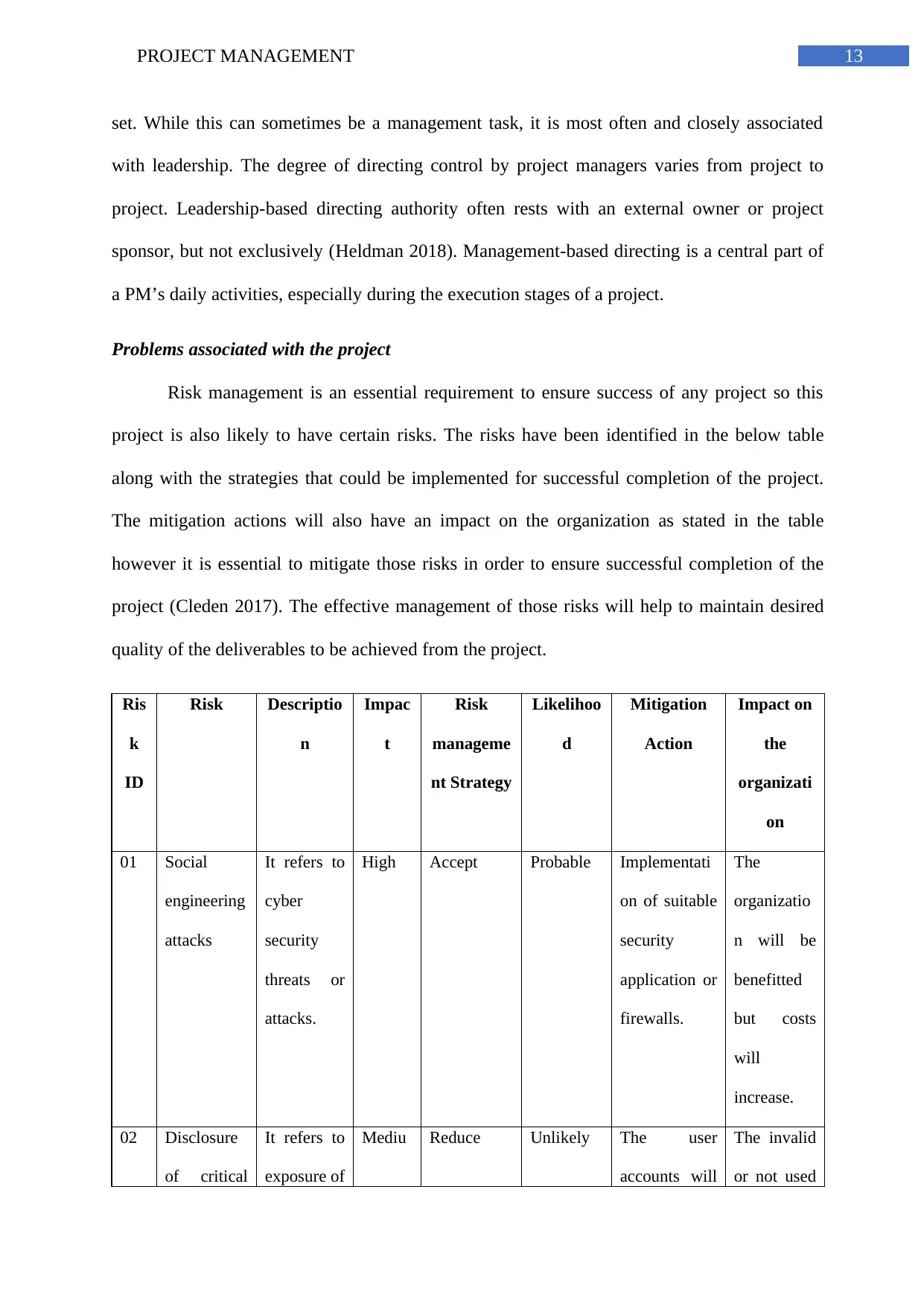
13PROJECT MANAGEMENT
set. While this can sometimes be a management task, it is most often and closely associated
with leadership. The degree of directing control by project managers varies from project to
project. Leadership-based directing authority often rests with an external owner or project
sponsor, but not exclusively (Heldman 2018). Management-based directing is a central part of
a PM’s daily activities, especially during the execution stages of a project.
Problems associated with the project
Risk management is an essential requirement to ensure success of any project so this
project is also likely to have certain risks. The risks have been identified in the below table
along with the strategies that could be implemented for successful completion of the project.
The mitigation actions will also have an impact on the organization as stated in the table
however it is essential to mitigate those risks in order to ensure successful completion of the
project (Cleden 2017). The effective management of those risks will help to maintain desired
quality of the deliverables to be achieved from the project.
Ris
k
ID
Risk Descriptio
n
Impac
t
Risk
manageme
nt Strategy
Likelihoo
d
Mitigation
Action
Impact on
the
organizati
on
01 Social
engineering
attacks
It refers to
cyber
security
threats or
attacks.
High Accept Probable Implementati
on of suitable
security
application or
firewalls.
The
organizatio
n will be
benefitted
but costs
will
increase.
02 Disclosure
of critical
It refers to
exposure of
Mediu Reduce Unlikely The user
accounts will
The invalid
or not used
set. While this can sometimes be a management task, it is most often and closely associated
with leadership. The degree of directing control by project managers varies from project to
project. Leadership-based directing authority often rests with an external owner or project
sponsor, but not exclusively (Heldman 2018). Management-based directing is a central part of
a PM’s daily activities, especially during the execution stages of a project.
Problems associated with the project
Risk management is an essential requirement to ensure success of any project so this
project is also likely to have certain risks. The risks have been identified in the below table
along with the strategies that could be implemented for successful completion of the project.
The mitigation actions will also have an impact on the organization as stated in the table
however it is essential to mitigate those risks in order to ensure successful completion of the
project (Cleden 2017). The effective management of those risks will help to maintain desired
quality of the deliverables to be achieved from the project.
Ris
k
ID
Risk Descriptio
n
Impac
t
Risk
manageme
nt Strategy
Likelihoo
d
Mitigation
Action
Impact on
the
organizati
on
01 Social
engineering
attacks
It refers to
cyber
security
threats or
attacks.
High Accept Probable Implementati
on of suitable
security
application or
firewalls.
The
organizatio
n will be
benefitted
but costs
will
increase.
02 Disclosure
of critical
It refers to
exposure of
Mediu Reduce Unlikely The user
accounts will
The invalid
or not used
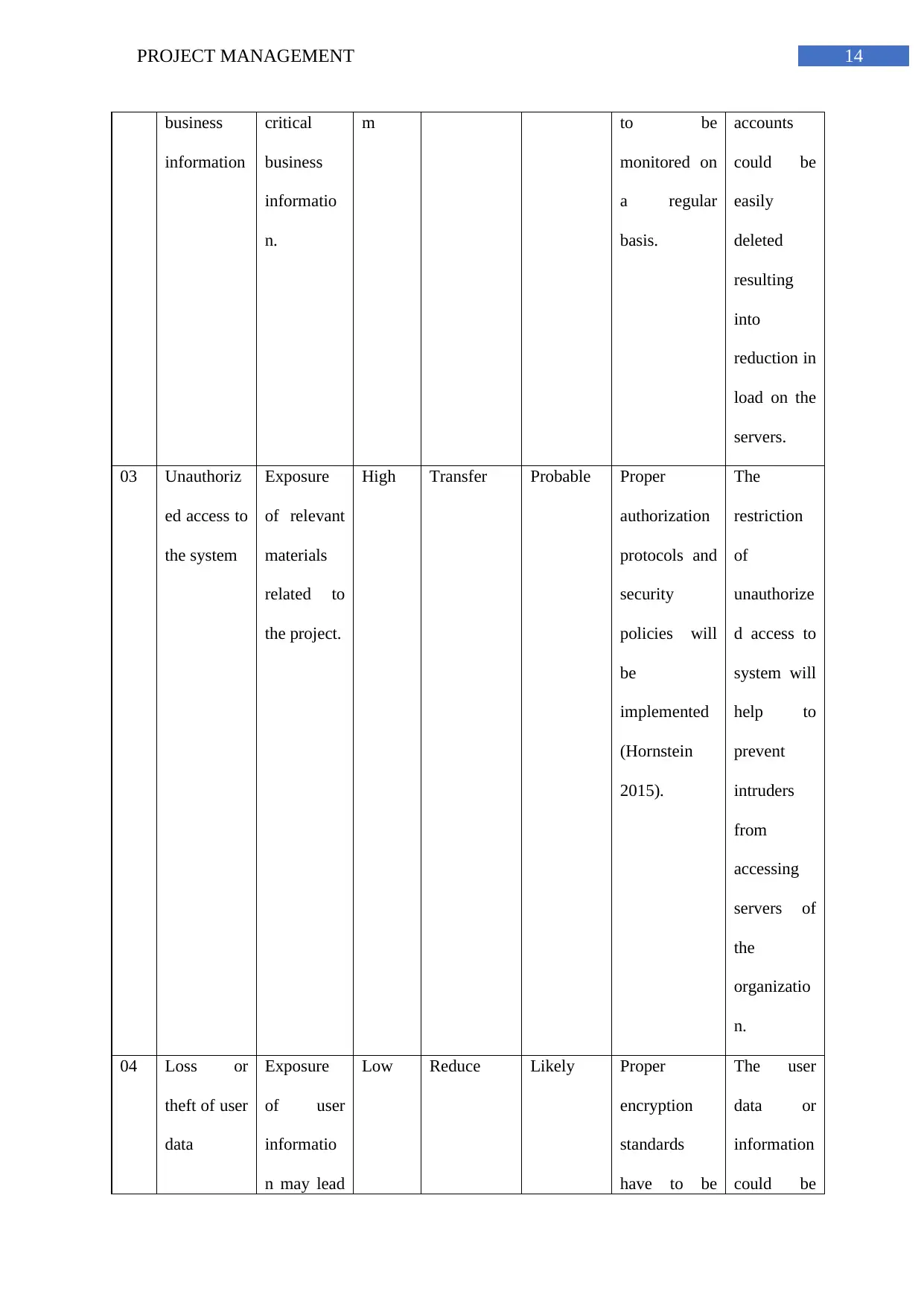
14PROJECT MANAGEMENT
business
information
critical
business
informatio
n.
m to be
monitored on
a regular
basis.
accounts
could be
easily
deleted
resulting
into
reduction in
load on the
servers.
03 Unauthoriz
ed access to
the system
Exposure
of relevant
materials
related to
the project.
High Transfer Probable Proper
authorization
protocols and
security
policies will
be
implemented
(Hornstein
2015).
The
restriction
of
unauthorize
d access to
system will
help to
prevent
intruders
from
accessing
servers of
the
organizatio
n.
04 Loss or
theft of user
data
Exposure
of user
informatio
n may lead
Low Reduce Likely Proper
encryption
standards
have to be
The user
data or
information
could be
business
information
critical
business
informatio
n.
m to be
monitored on
a regular
basis.
accounts
could be
easily
deleted
resulting
into
reduction in
load on the
servers.
03 Unauthoriz
ed access to
the system
Exposure
of relevant
materials
related to
the project.
High Transfer Probable Proper
authorization
protocols and
security
policies will
be
implemented
(Hornstein
2015).
The
restriction
of
unauthorize
d access to
system will
help to
prevent
intruders
from
accessing
servers of
the
organizatio
n.
04 Loss or
theft of user
data
Exposure
of user
informatio
n may lead
Low Reduce Likely Proper
encryption
standards
have to be
The user
data or
information
could be
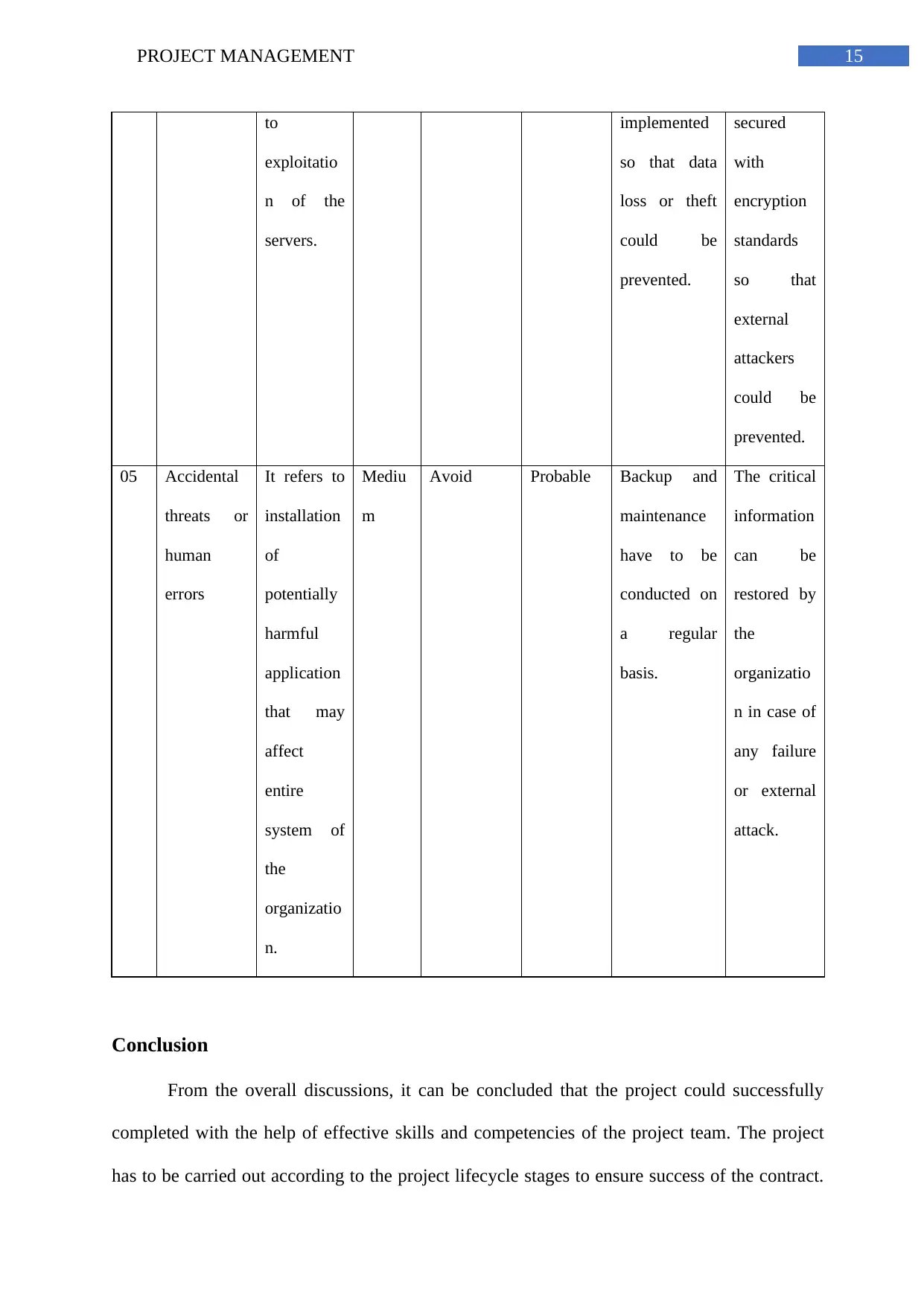
15PROJECT MANAGEMENT
to
exploitatio
n of the
servers.
implemented
so that data
loss or theft
could be
prevented.
secured
with
encryption
standards
so that
external
attackers
could be
prevented.
05 Accidental
threats or
human
errors
It refers to
installation
of
potentially
harmful
application
that may
affect
entire
system of
the
organizatio
n.
Mediu
m
Avoid Probable Backup and
maintenance
have to be
conducted on
a regular
basis.
The critical
information
can be
restored by
the
organizatio
n in case of
any failure
or external
attack.
Conclusion
From the overall discussions, it can be concluded that the project could successfully
completed with the help of effective skills and competencies of the project team. The project
has to be carried out according to the project lifecycle stages to ensure success of the contract.
to
exploitatio
n of the
servers.
implemented
so that data
loss or theft
could be
prevented.
secured
with
encryption
standards
so that
external
attackers
could be
prevented.
05 Accidental
threats or
human
errors
It refers to
installation
of
potentially
harmful
application
that may
affect
entire
system of
the
organizatio
n.
Mediu
m
Avoid Probable Backup and
maintenance
have to be
conducted on
a regular
basis.
The critical
information
can be
restored by
the
organizatio
n in case of
any failure
or external
attack.
Conclusion
From the overall discussions, it can be concluded that the project could successfully
completed with the help of effective skills and competencies of the project team. The project
has to be carried out according to the project lifecycle stages to ensure success of the contract.
Secure Best Marks with AI Grader
Need help grading? Try our AI Grader for instant feedback on your assignments.
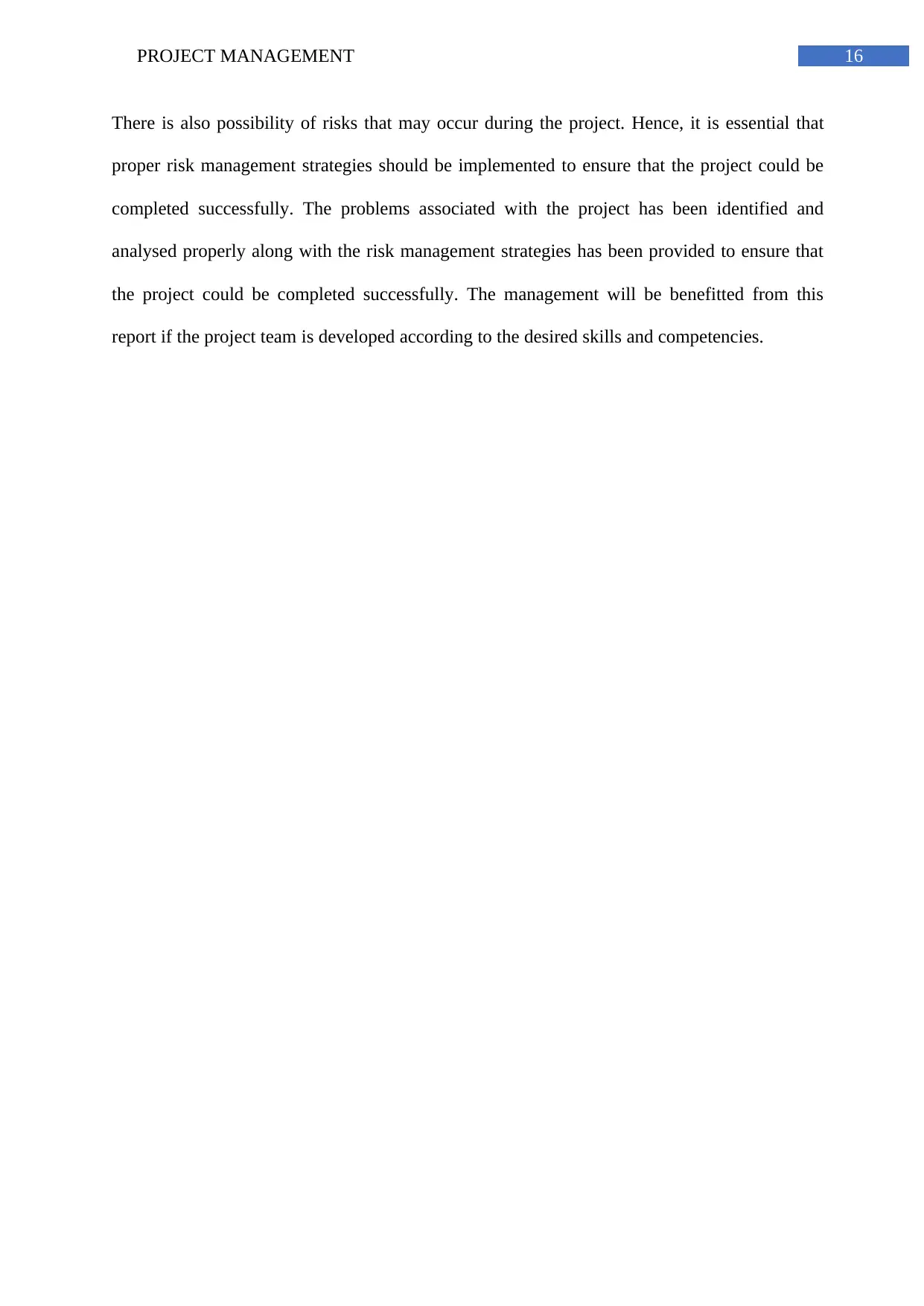
16PROJECT MANAGEMENT
There is also possibility of risks that may occur during the project. Hence, it is essential that
proper risk management strategies should be implemented to ensure that the project could be
completed successfully. The problems associated with the project has been identified and
analysed properly along with the risk management strategies has been provided to ensure that
the project could be completed successfully. The management will be benefitted from this
report if the project team is developed according to the desired skills and competencies.
There is also possibility of risks that may occur during the project. Hence, it is essential that
proper risk management strategies should be implemented to ensure that the project could be
completed successfully. The problems associated with the project has been identified and
analysed properly along with the risk management strategies has been provided to ensure that
the project could be completed successfully. The management will be benefitted from this
report if the project team is developed according to the desired skills and competencies.
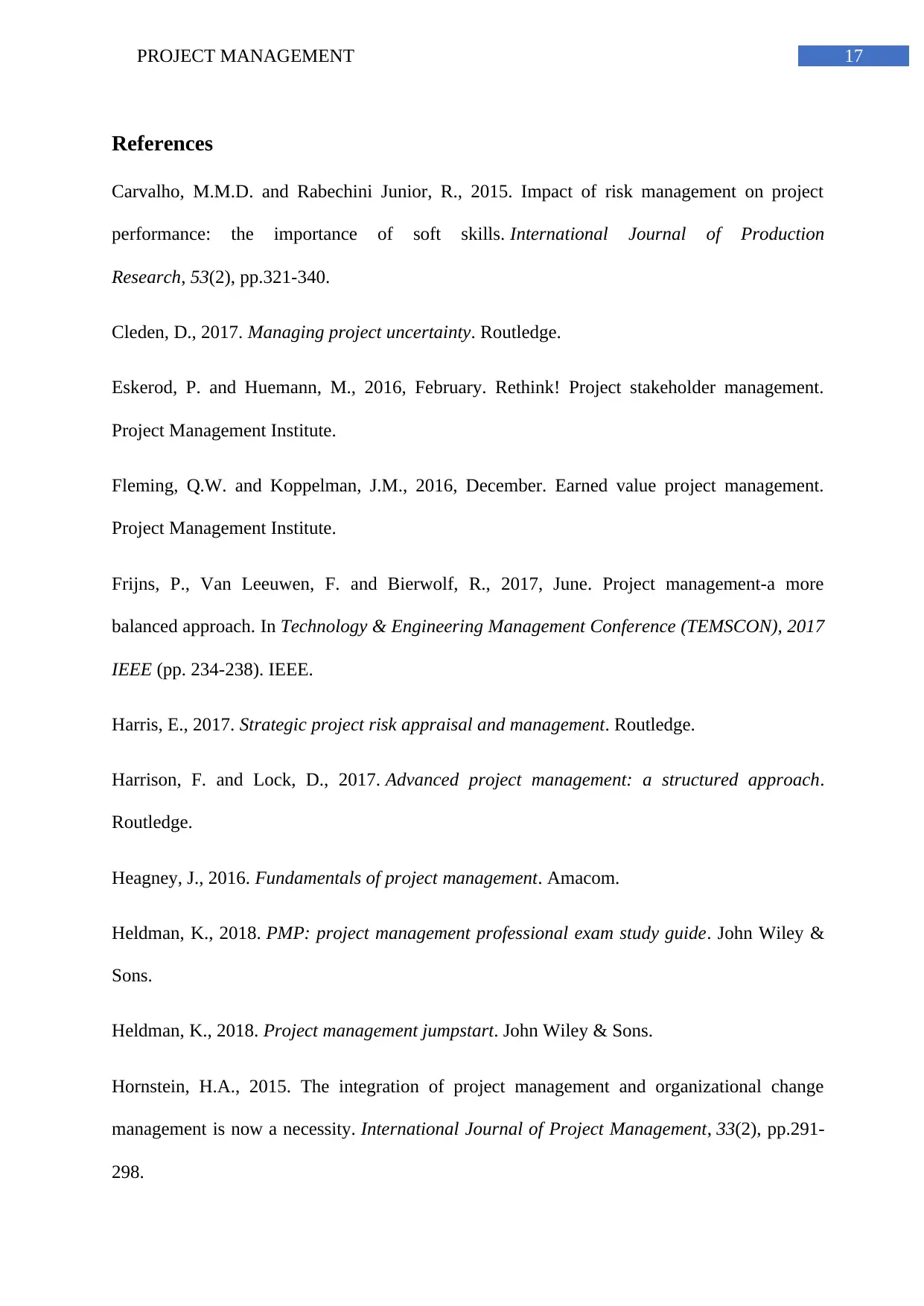
17PROJECT MANAGEMENT
References
Carvalho, M.M.D. and Rabechini Junior, R., 2015. Impact of risk management on project
performance: the importance of soft skills. International Journal of Production
Research, 53(2), pp.321-340.
Cleden, D., 2017. Managing project uncertainty. Routledge.
Eskerod, P. and Huemann, M., 2016, February. Rethink! Project stakeholder management.
Project Management Institute.
Fleming, Q.W. and Koppelman, J.M., 2016, December. Earned value project management.
Project Management Institute.
Frijns, P., Van Leeuwen, F. and Bierwolf, R., 2017, June. Project management-a more
balanced approach. In Technology & Engineering Management Conference (TEMSCON), 2017
IEEE (pp. 234-238). IEEE.
Harris, E., 2017. Strategic project risk appraisal and management. Routledge.
Harrison, F. and Lock, D., 2017. Advanced project management: a structured approach.
Routledge.
Heagney, J., 2016. Fundamentals of project management. Amacom.
Heldman, K., 2018. PMP: project management professional exam study guide. John Wiley &
Sons.
Heldman, K., 2018. Project management jumpstart. John Wiley & Sons.
Hornstein, H.A., 2015. The integration of project management and organizational change
management is now a necessity. International Journal of Project Management, 33(2), pp.291-
298.
References
Carvalho, M.M.D. and Rabechini Junior, R., 2015. Impact of risk management on project
performance: the importance of soft skills. International Journal of Production
Research, 53(2), pp.321-340.
Cleden, D., 2017. Managing project uncertainty. Routledge.
Eskerod, P. and Huemann, M., 2016, February. Rethink! Project stakeholder management.
Project Management Institute.
Fleming, Q.W. and Koppelman, J.M., 2016, December. Earned value project management.
Project Management Institute.
Frijns, P., Van Leeuwen, F. and Bierwolf, R., 2017, June. Project management-a more
balanced approach. In Technology & Engineering Management Conference (TEMSCON), 2017
IEEE (pp. 234-238). IEEE.
Harris, E., 2017. Strategic project risk appraisal and management. Routledge.
Harrison, F. and Lock, D., 2017. Advanced project management: a structured approach.
Routledge.
Heagney, J., 2016. Fundamentals of project management. Amacom.
Heldman, K., 2018. PMP: project management professional exam study guide. John Wiley &
Sons.
Heldman, K., 2018. Project management jumpstart. John Wiley & Sons.
Hornstein, H.A., 2015. The integration of project management and organizational change
management is now a necessity. International Journal of Project Management, 33(2), pp.291-
298.
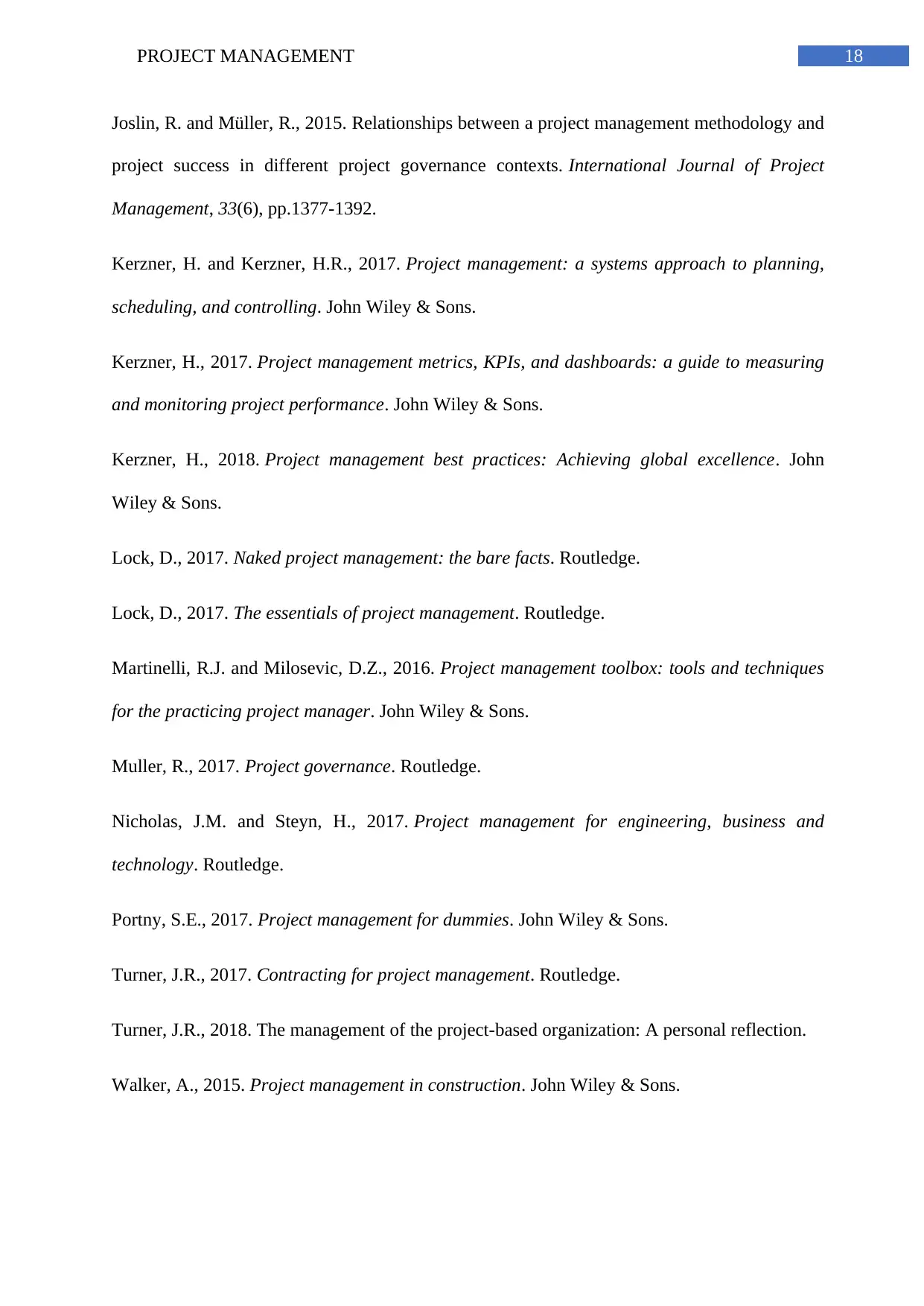
18PROJECT MANAGEMENT
Joslin, R. and Müller, R., 2015. Relationships between a project management methodology and
project success in different project governance contexts. International Journal of Project
Management, 33(6), pp.1377-1392.
Kerzner, H. and Kerzner, H.R., 2017. Project management: a systems approach to planning,
scheduling, and controlling. John Wiley & Sons.
Kerzner, H., 2017. Project management metrics, KPIs, and dashboards: a guide to measuring
and monitoring project performance. John Wiley & Sons.
Kerzner, H., 2018. Project management best practices: Achieving global excellence. John
Wiley & Sons.
Lock, D., 2017. Naked project management: the bare facts. Routledge.
Lock, D., 2017. The essentials of project management. Routledge.
Martinelli, R.J. and Milosevic, D.Z., 2016. Project management toolbox: tools and techniques
for the practicing project manager. John Wiley & Sons.
Muller, R., 2017. Project governance. Routledge.
Nicholas, J.M. and Steyn, H., 2017. Project management for engineering, business and
technology. Routledge.
Portny, S.E., 2017. Project management for dummies. John Wiley & Sons.
Turner, J.R., 2017. Contracting for project management. Routledge.
Turner, J.R., 2018. The management of the project-based organization: A personal reflection.
Walker, A., 2015. Project management in construction. John Wiley & Sons.
Joslin, R. and Müller, R., 2015. Relationships between a project management methodology and
project success in different project governance contexts. International Journal of Project
Management, 33(6), pp.1377-1392.
Kerzner, H. and Kerzner, H.R., 2017. Project management: a systems approach to planning,
scheduling, and controlling. John Wiley & Sons.
Kerzner, H., 2017. Project management metrics, KPIs, and dashboards: a guide to measuring
and monitoring project performance. John Wiley & Sons.
Kerzner, H., 2018. Project management best practices: Achieving global excellence. John
Wiley & Sons.
Lock, D., 2017. Naked project management: the bare facts. Routledge.
Lock, D., 2017. The essentials of project management. Routledge.
Martinelli, R.J. and Milosevic, D.Z., 2016. Project management toolbox: tools and techniques
for the practicing project manager. John Wiley & Sons.
Muller, R., 2017. Project governance. Routledge.
Nicholas, J.M. and Steyn, H., 2017. Project management for engineering, business and
technology. Routledge.
Portny, S.E., 2017. Project management for dummies. John Wiley & Sons.
Turner, J.R., 2017. Contracting for project management. Routledge.
Turner, J.R., 2018. The management of the project-based organization: A personal reflection.
Walker, A., 2015. Project management in construction. John Wiley & Sons.
Paraphrase This Document
Need a fresh take? Get an instant paraphrase of this document with our AI Paraphraser
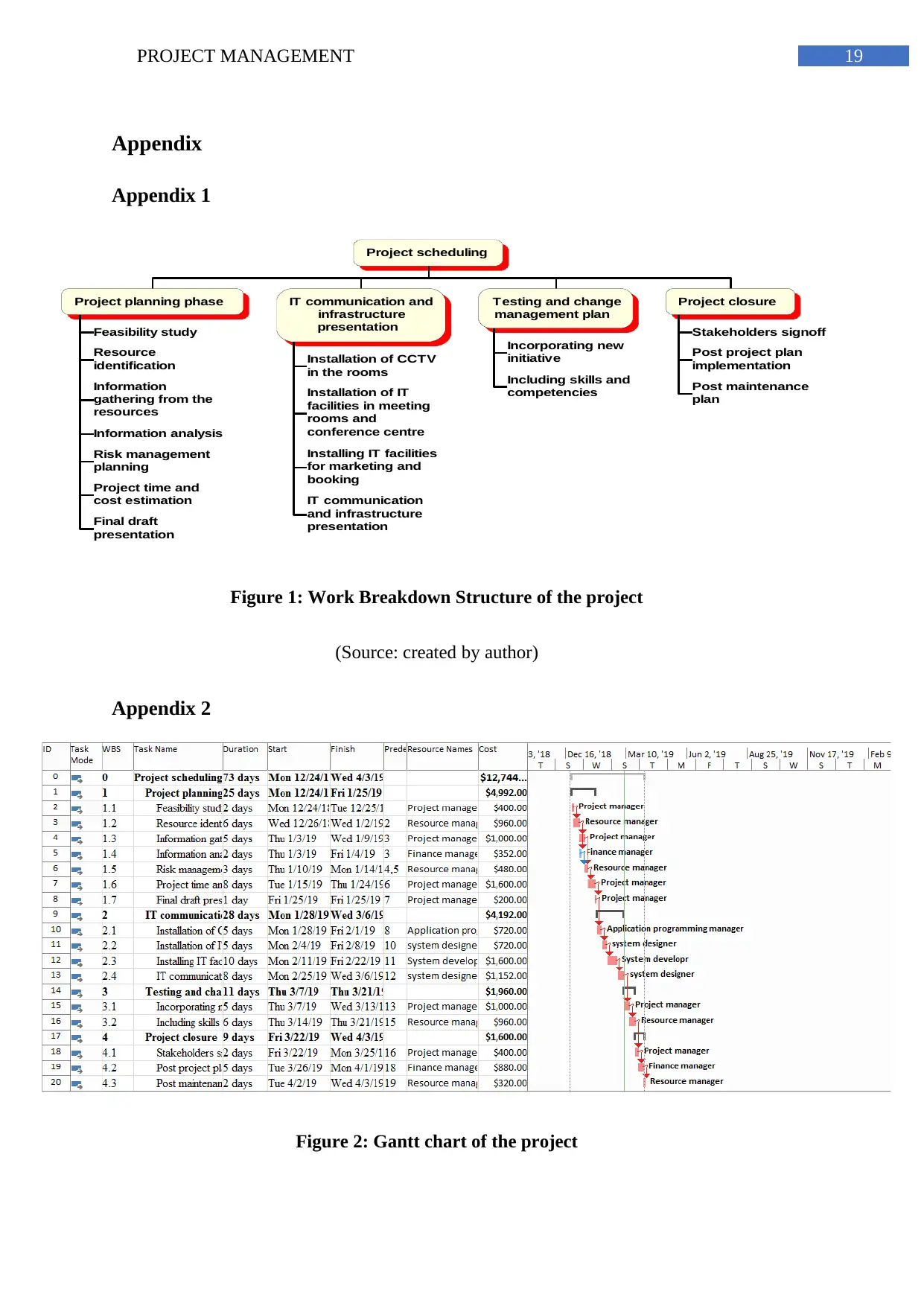
19PROJECT MANAGEMENT
Appendix
Appendix 1
Project scheduling
Project planning phase
Feasibility study
Resource
identification
Information
gathering from the
resources
Information analysis
Risk management
planning
Project time and
cost estimation
Final draft
presentation
IT communication and
infrastructure
presentation
Installation of CCTV
in the rooms
Installation of IT
facilities in meeting
rooms and
conference centre
Installing IT facilities
for marketing and
booking
IT communication
and infrastructure
presentation
Testing and change
management plan
Incorporating new
initiative
Including skills and
competencies
Project closure
Stakeholders signoff
Post project plan
implementation
Post maintenance
plan
Figure 1: Work Breakdown Structure of the project
(Source: created by author)
Appendix 2
Figure 2: Gantt chart of the project
Appendix
Appendix 1
Project scheduling
Project planning phase
Feasibility study
Resource
identification
Information
gathering from the
resources
Information analysis
Risk management
planning
Project time and
cost estimation
Final draft
presentation
IT communication and
infrastructure
presentation
Installation of CCTV
in the rooms
Installation of IT
facilities in meeting
rooms and
conference centre
Installing IT facilities
for marketing and
booking
IT communication
and infrastructure
presentation
Testing and change
management plan
Incorporating new
initiative
Including skills and
competencies
Project closure
Stakeholders signoff
Post project plan
implementation
Post maintenance
plan
Figure 1: Work Breakdown Structure of the project
(Source: created by author)
Appendix 2
Figure 2: Gantt chart of the project

20PROJECT MANAGEMENT
(Source: created by author)
(Source: created by author)
1 out of 21
Related Documents
Your All-in-One AI-Powered Toolkit for Academic Success.
+13062052269
info@desklib.com
Available 24*7 on WhatsApp / Email
![[object Object]](/_next/static/media/star-bottom.7253800d.svg)
Unlock your academic potential
© 2024 | Zucol Services PVT LTD | All rights reserved.





